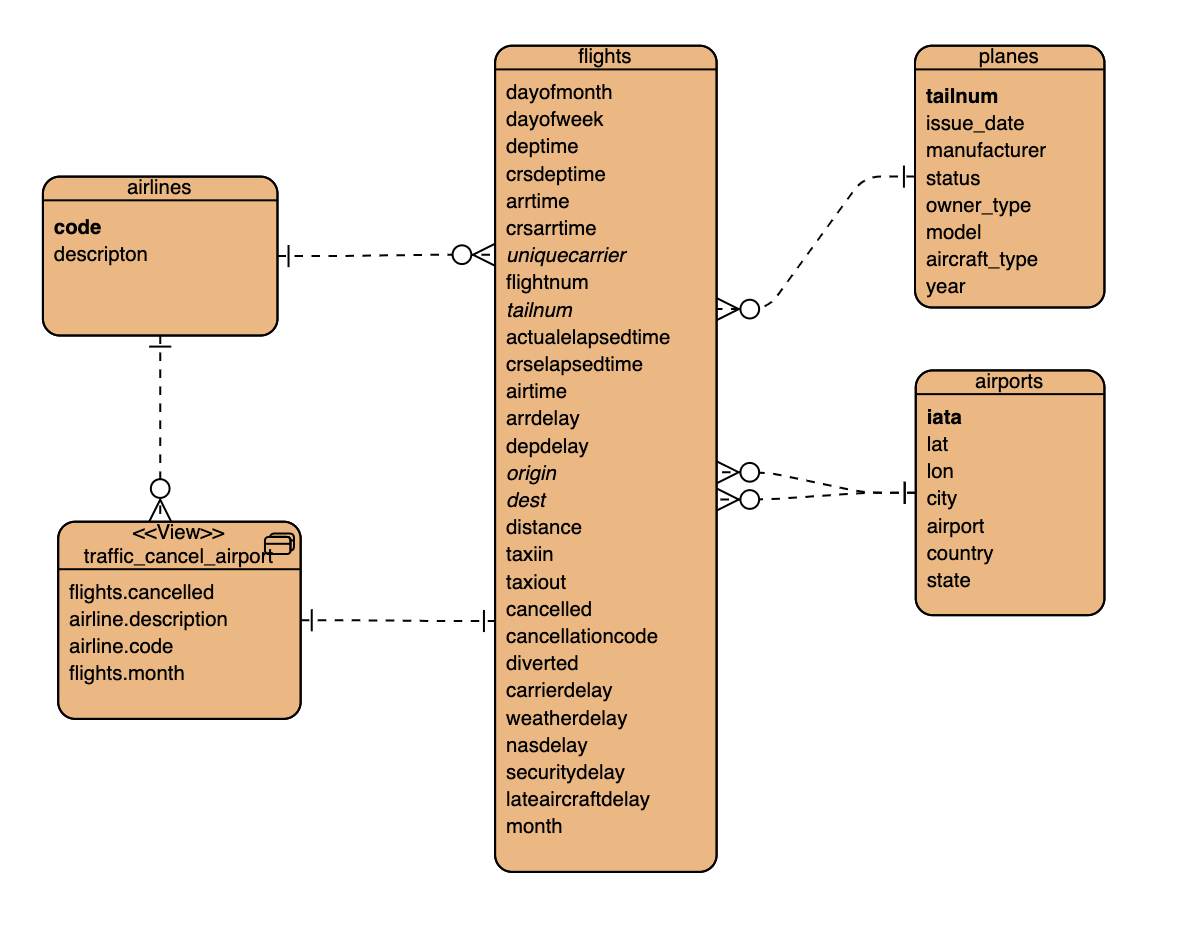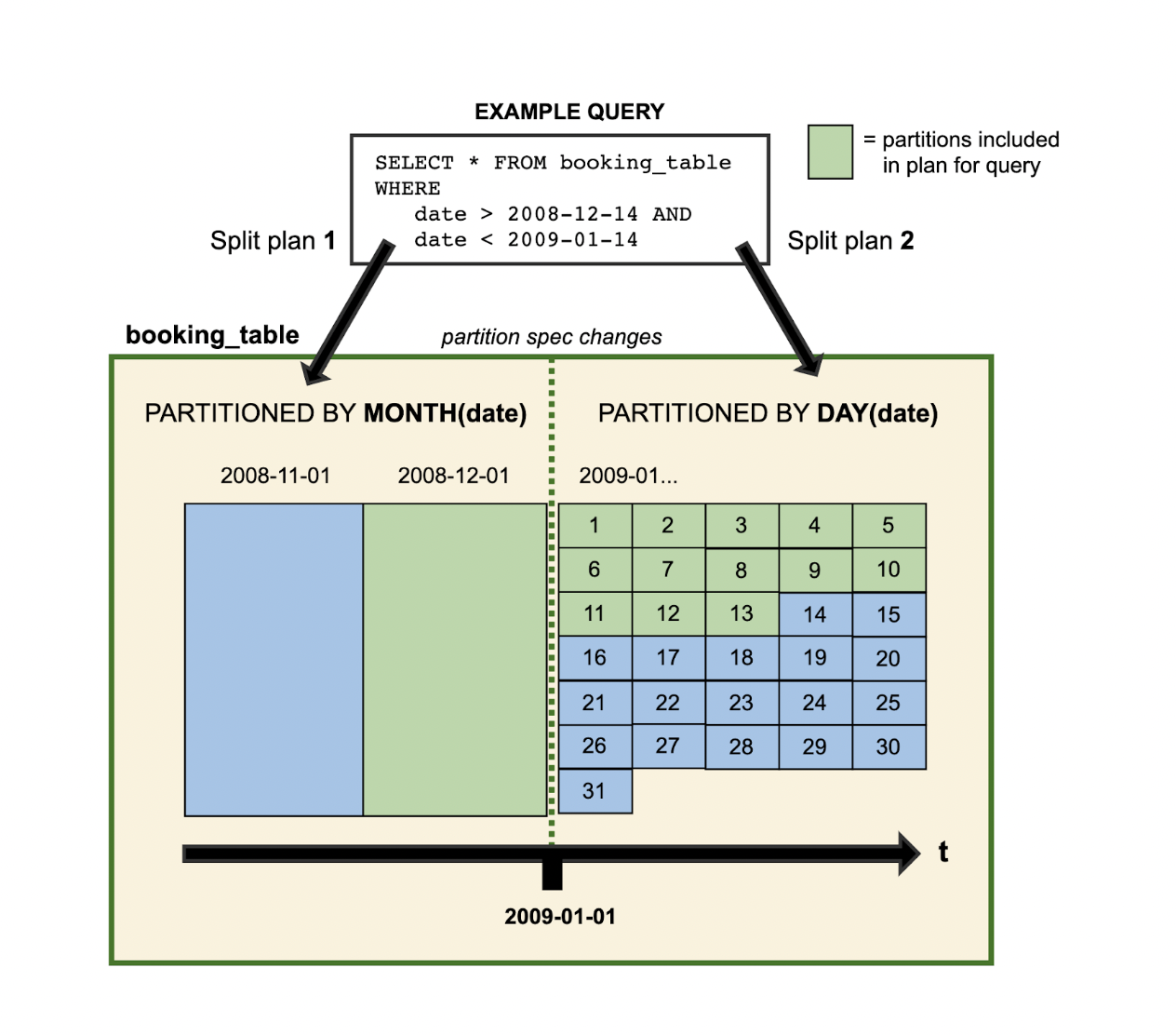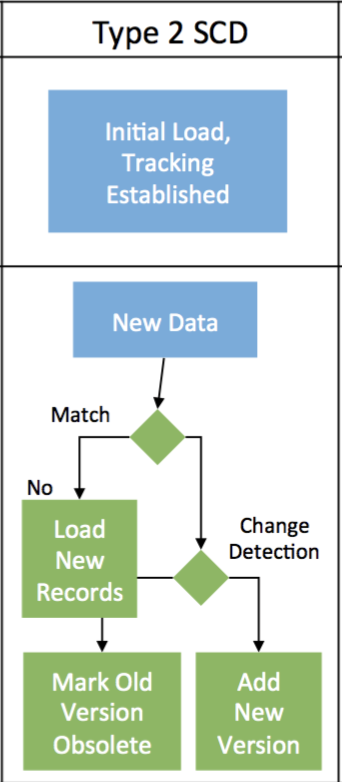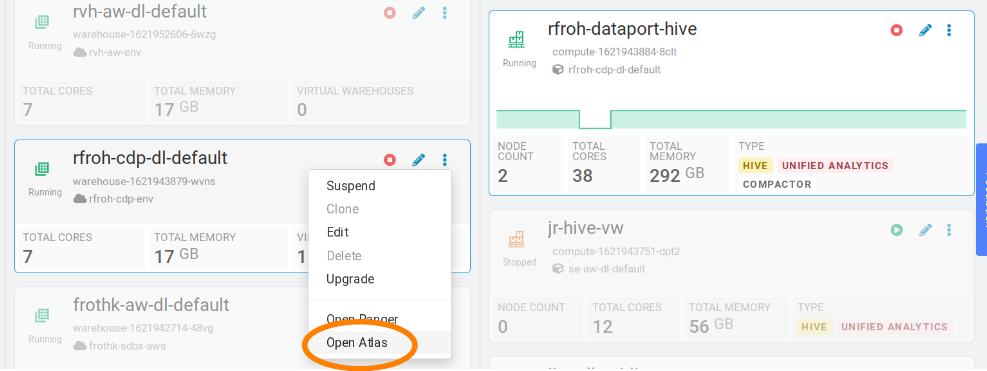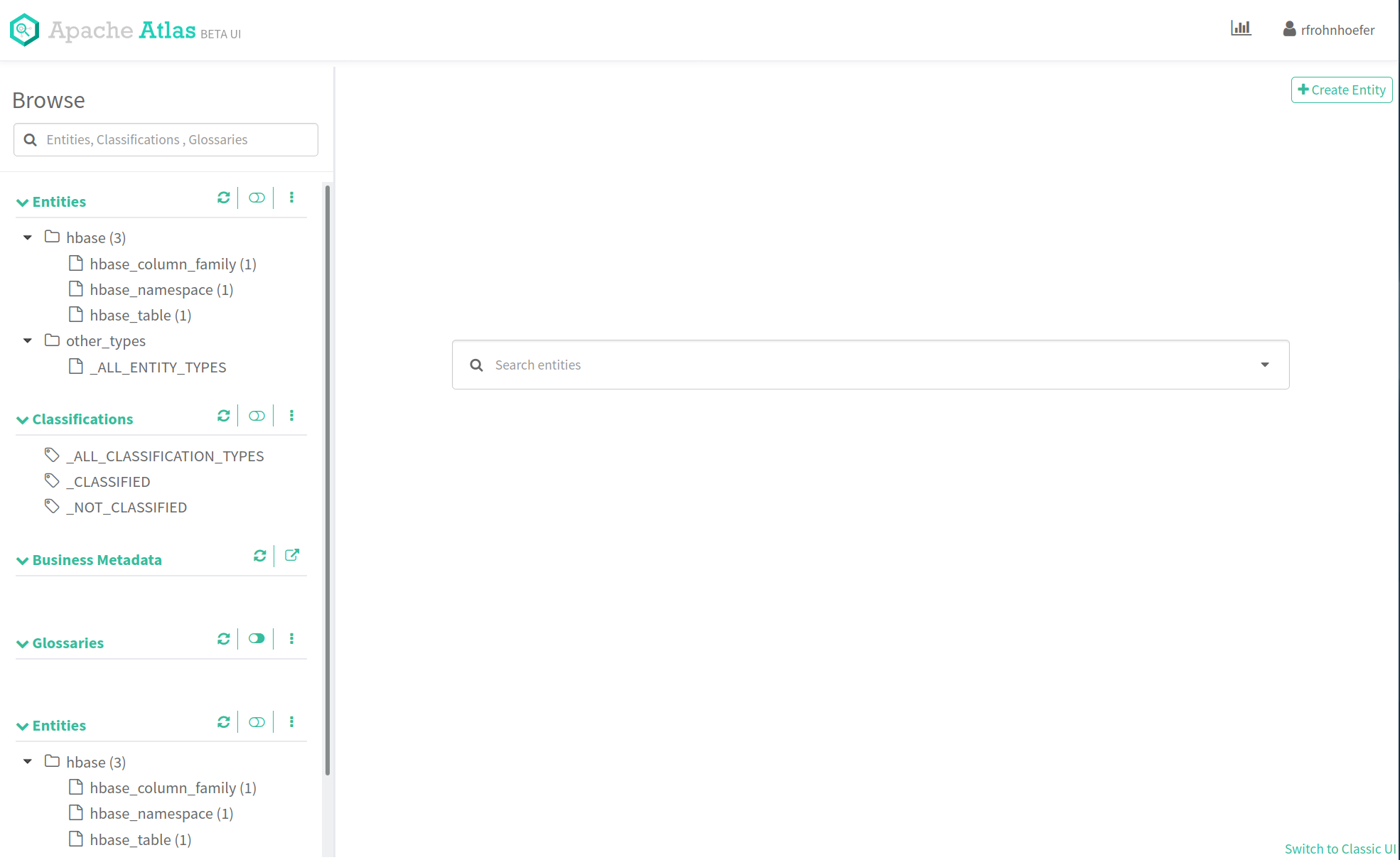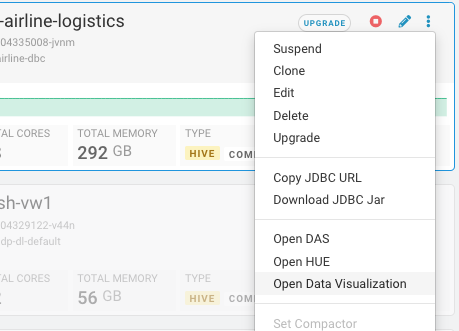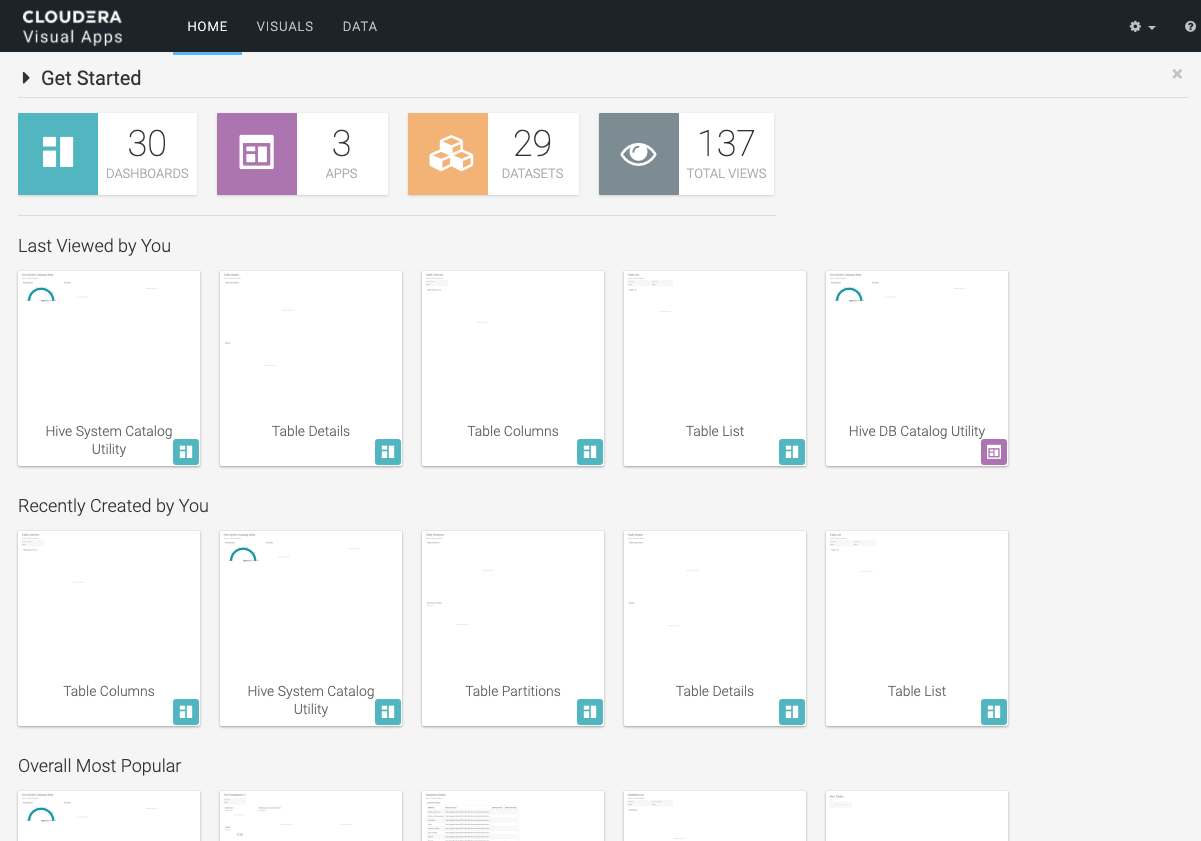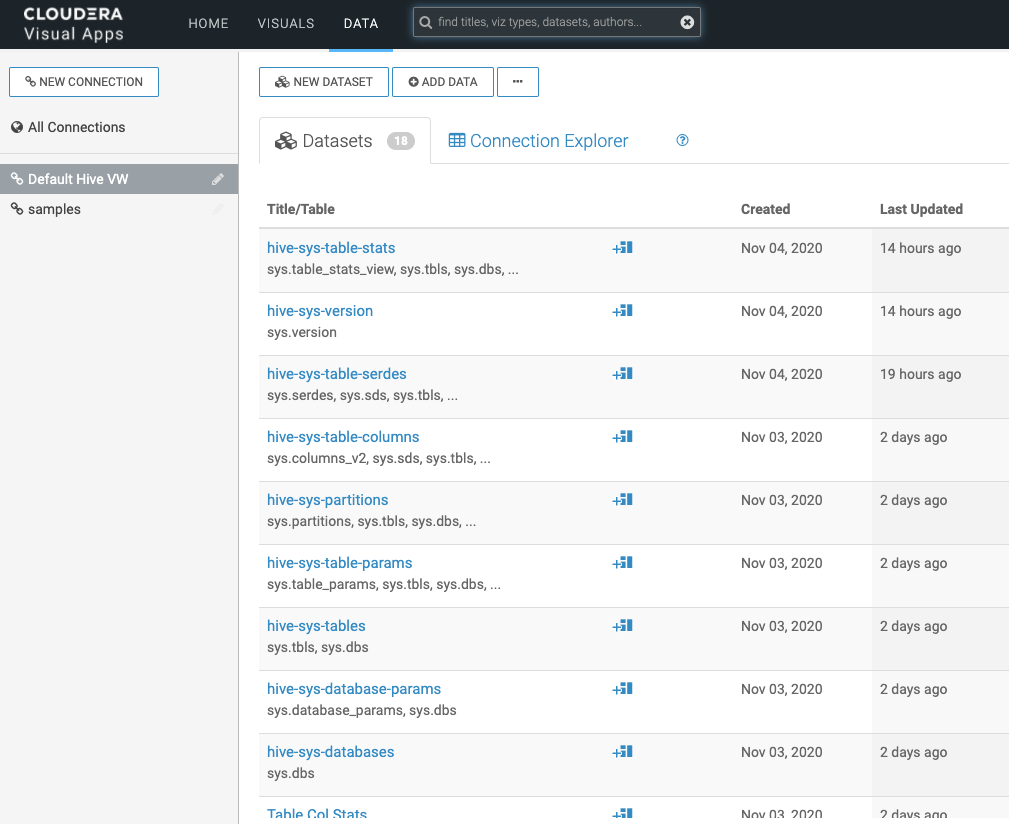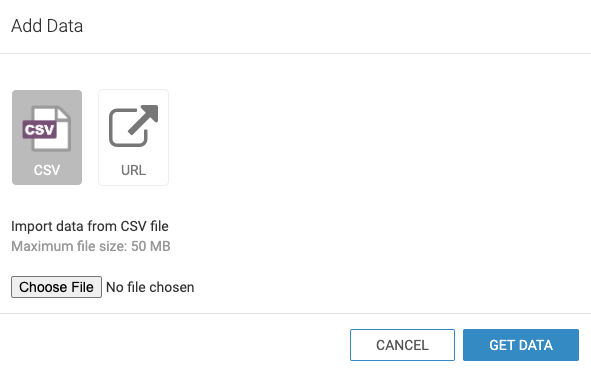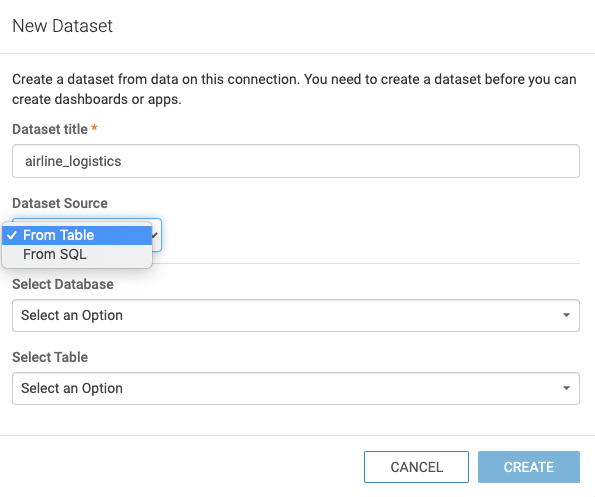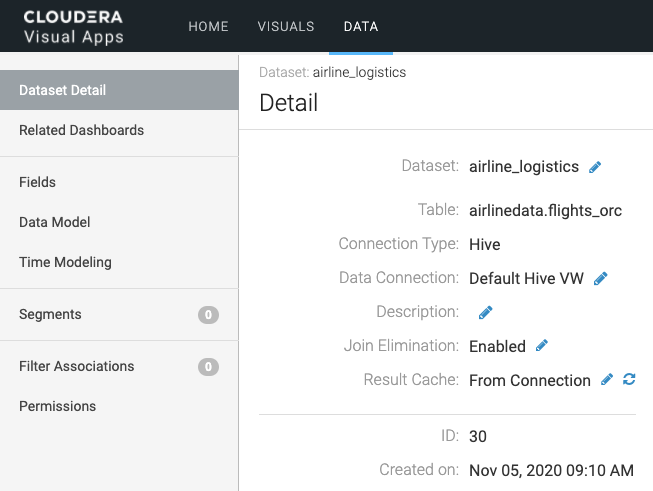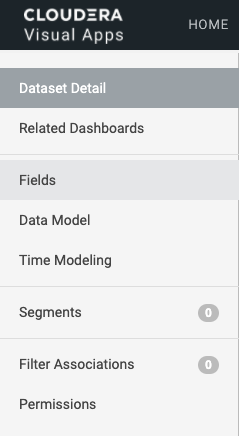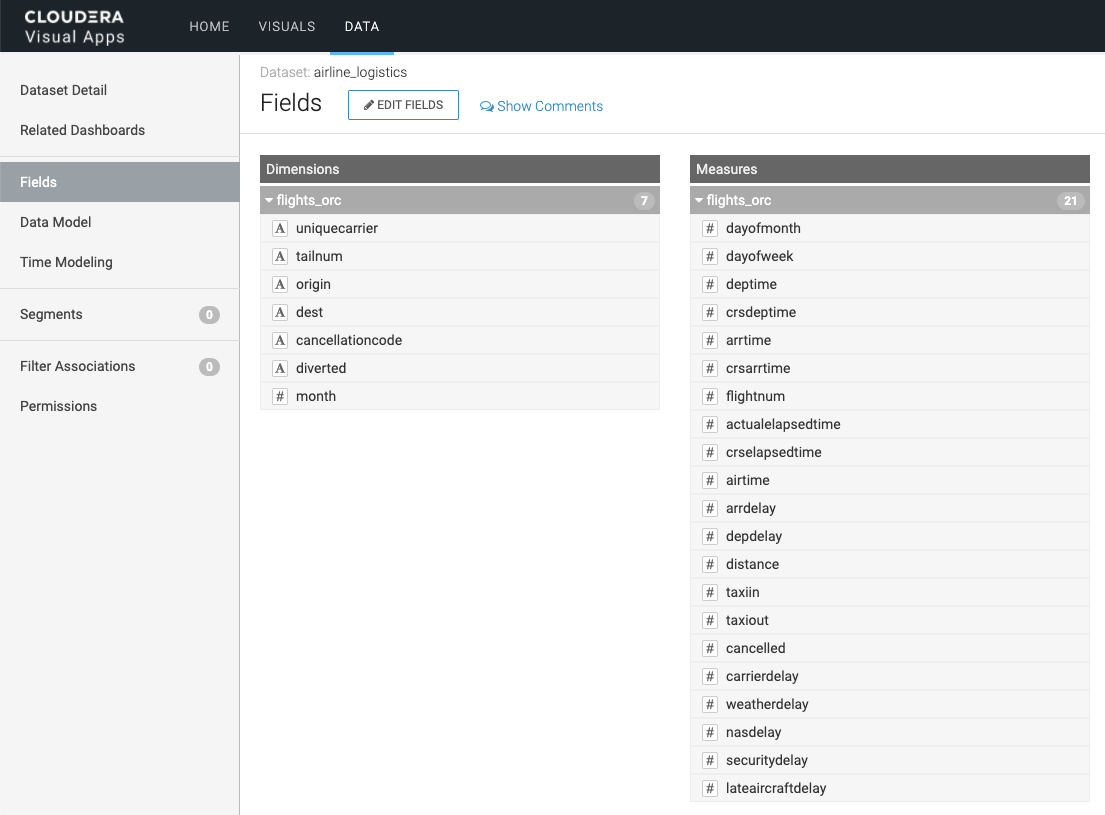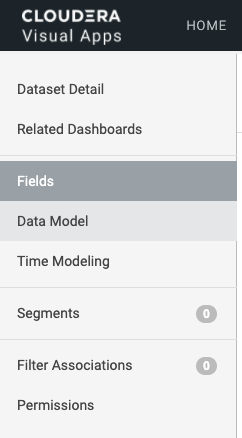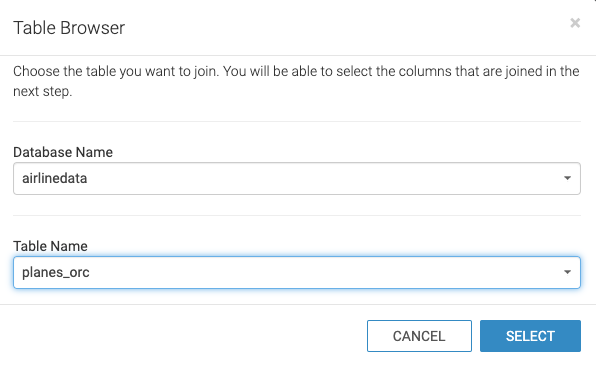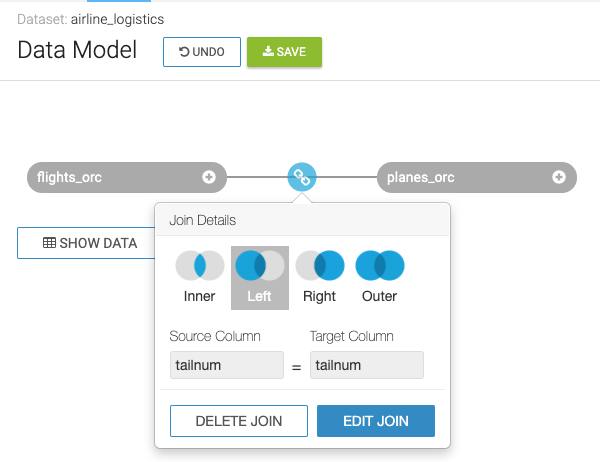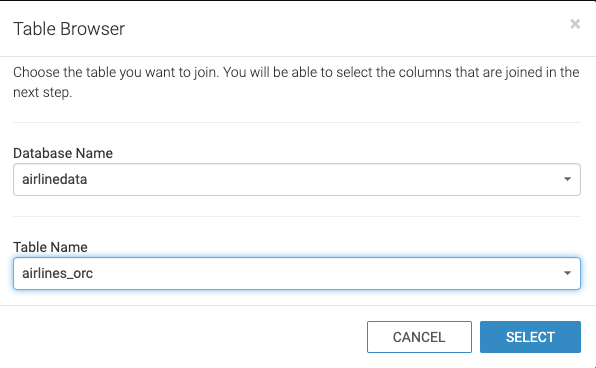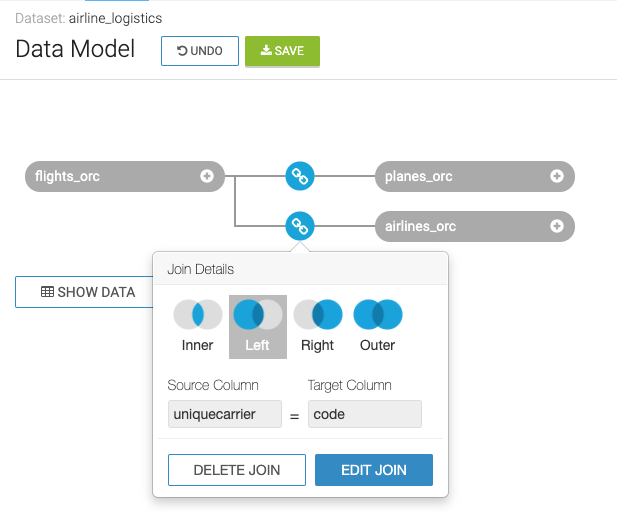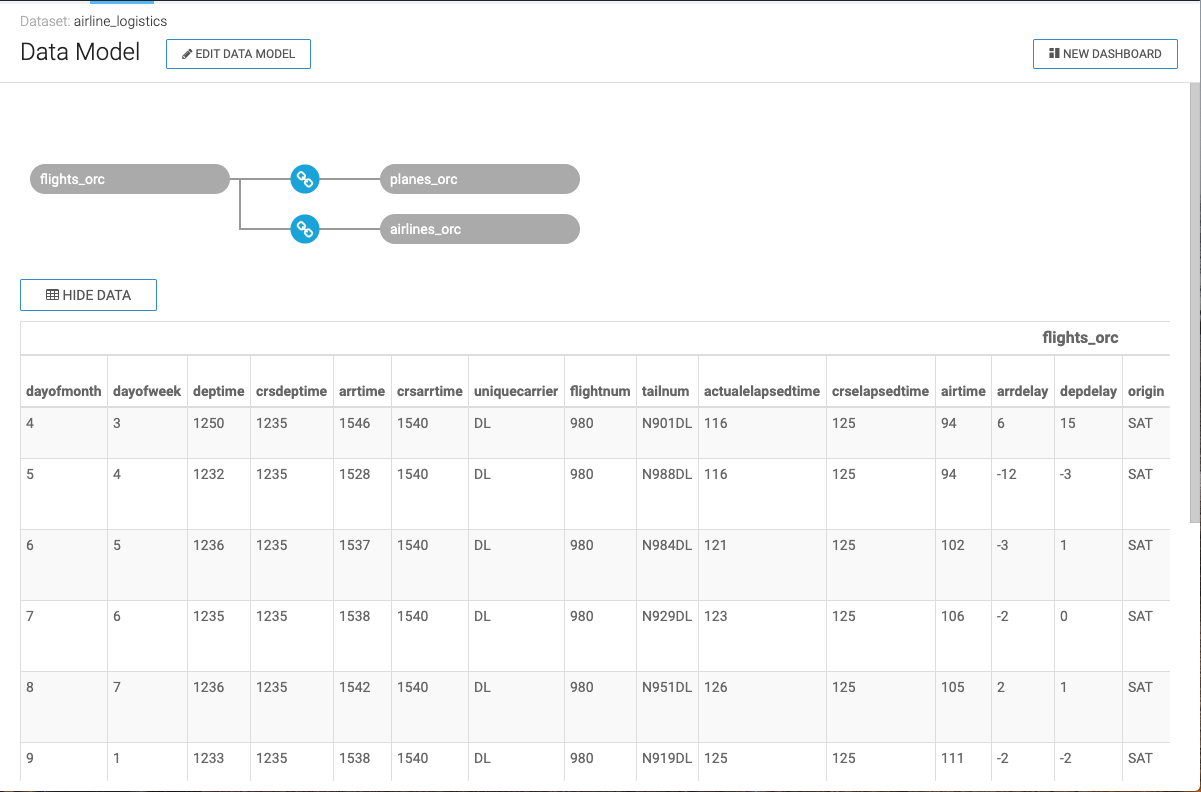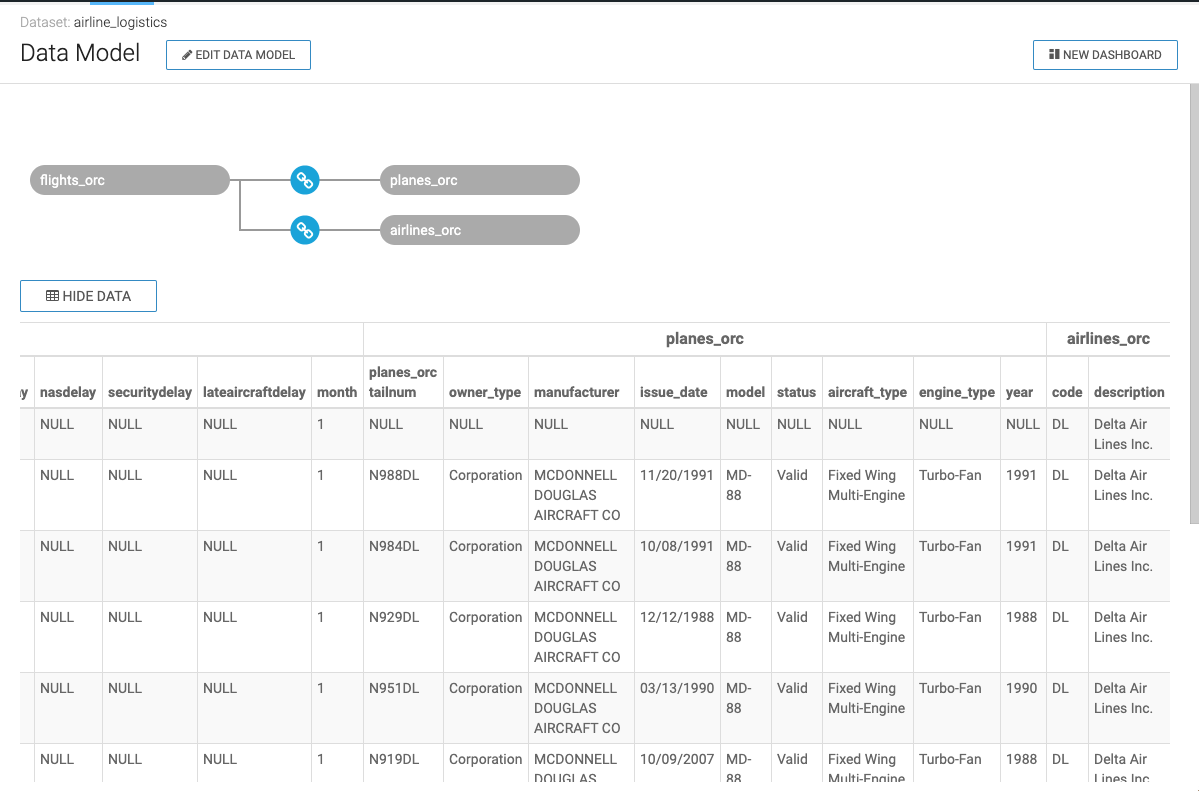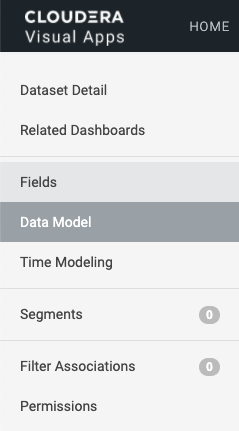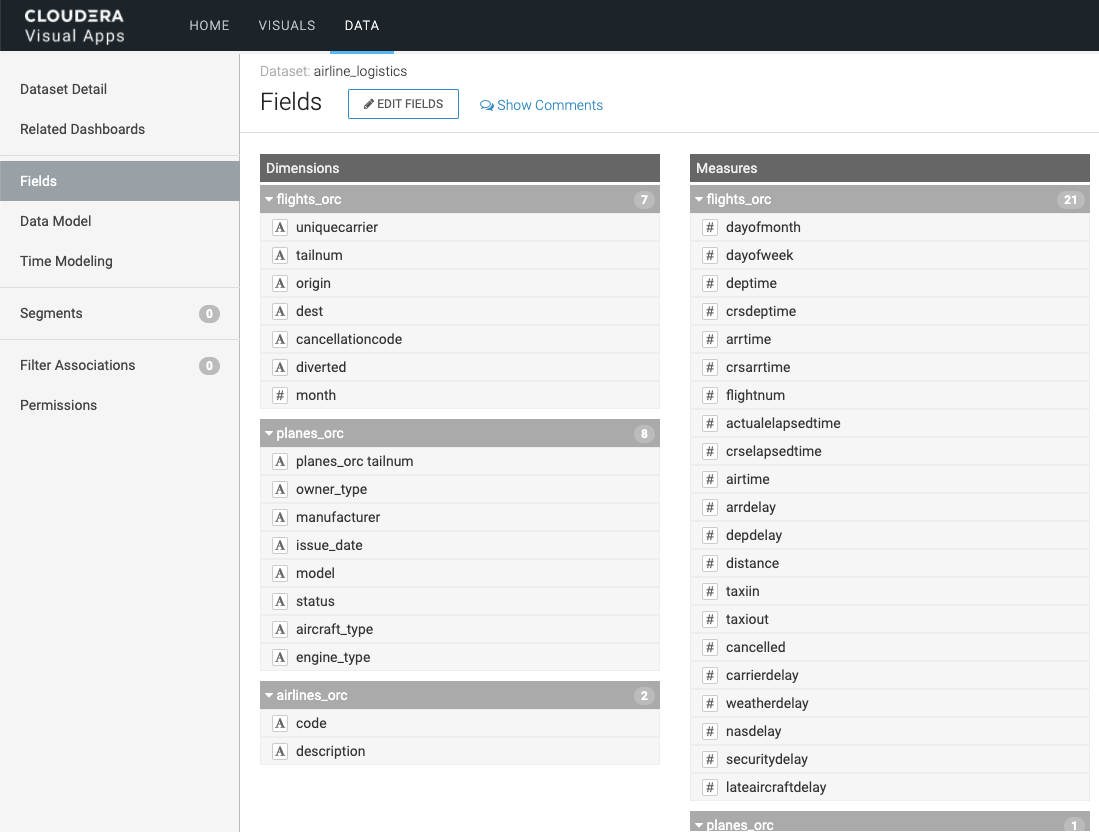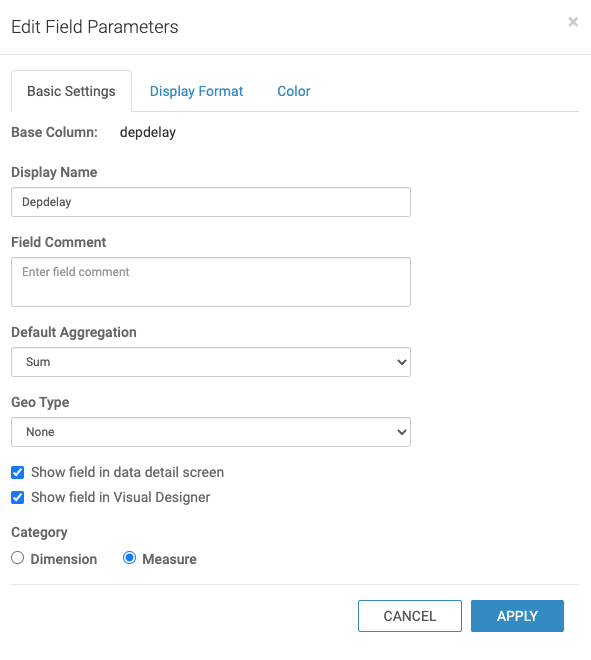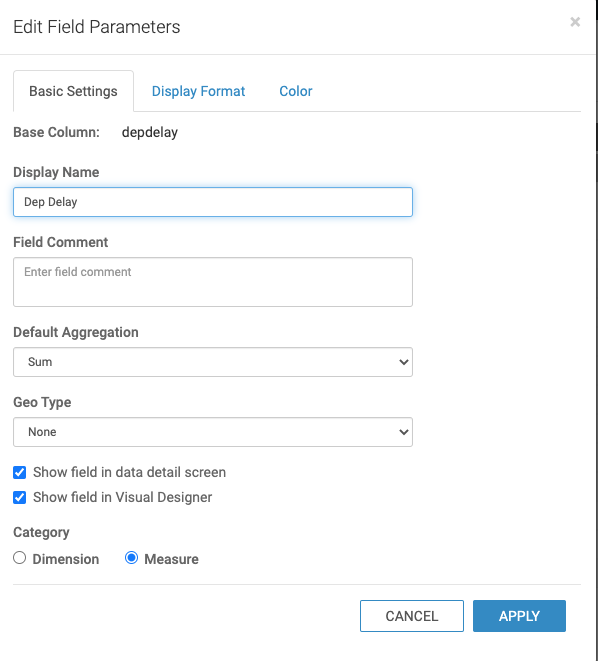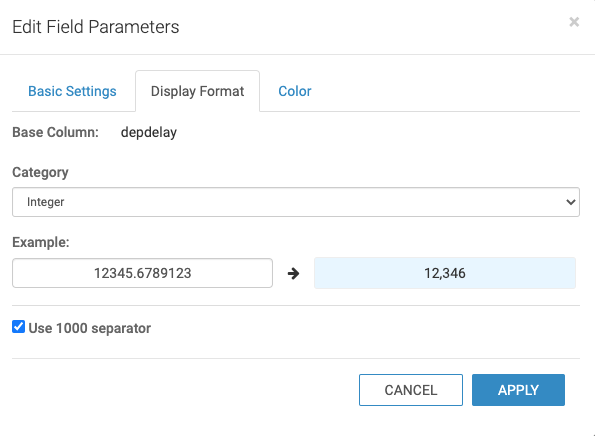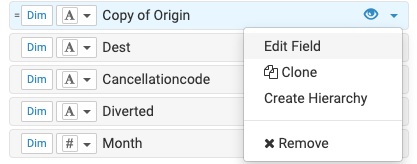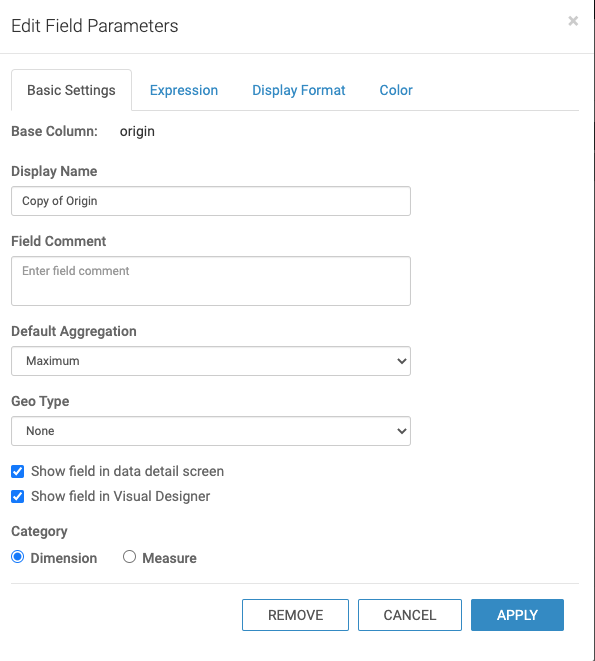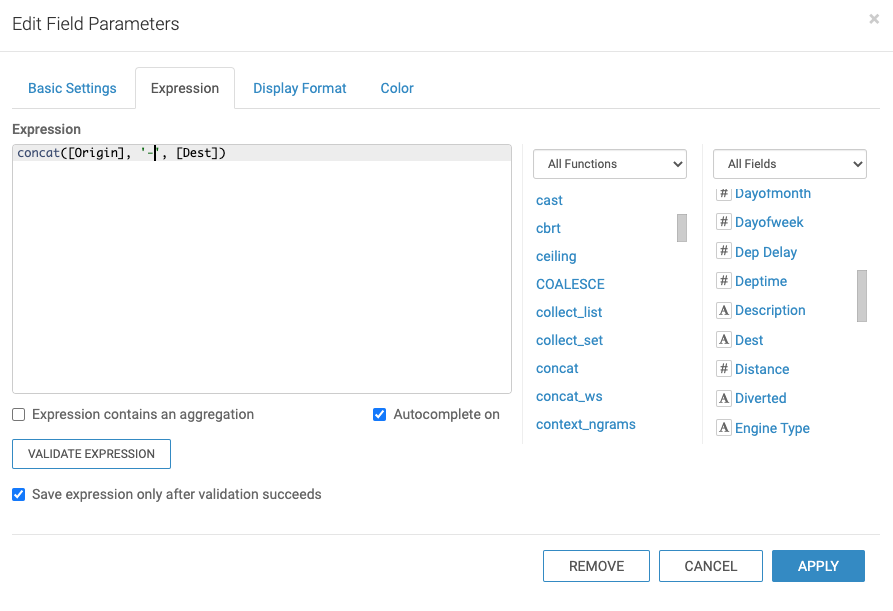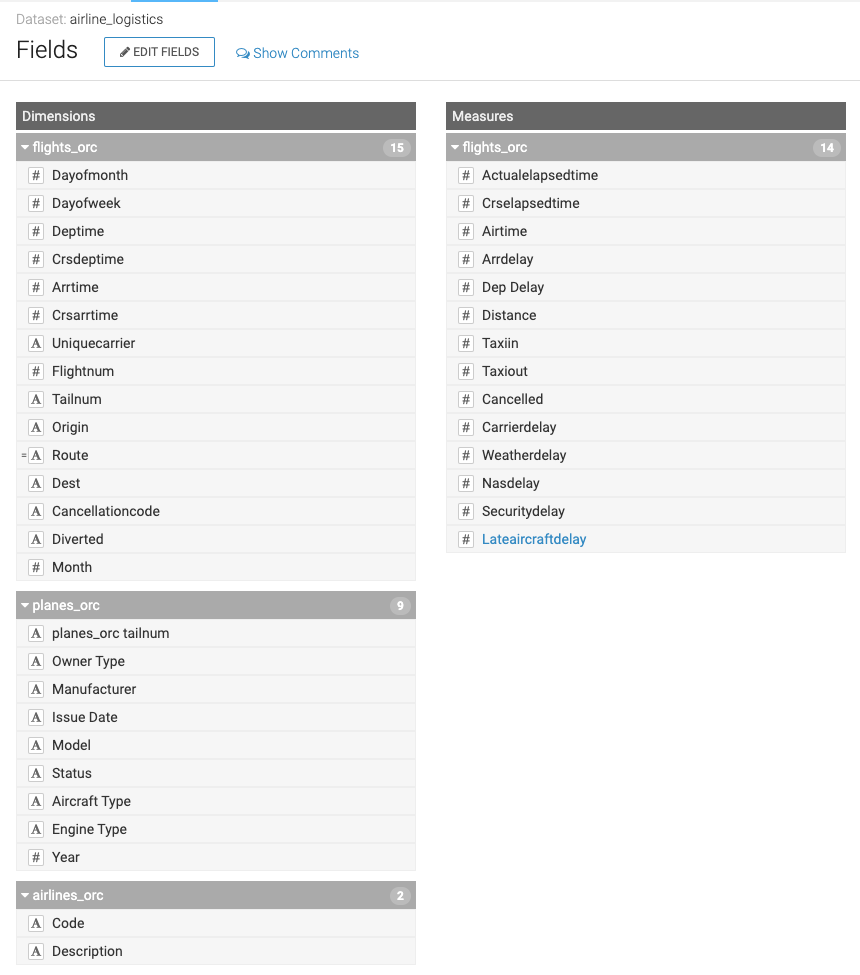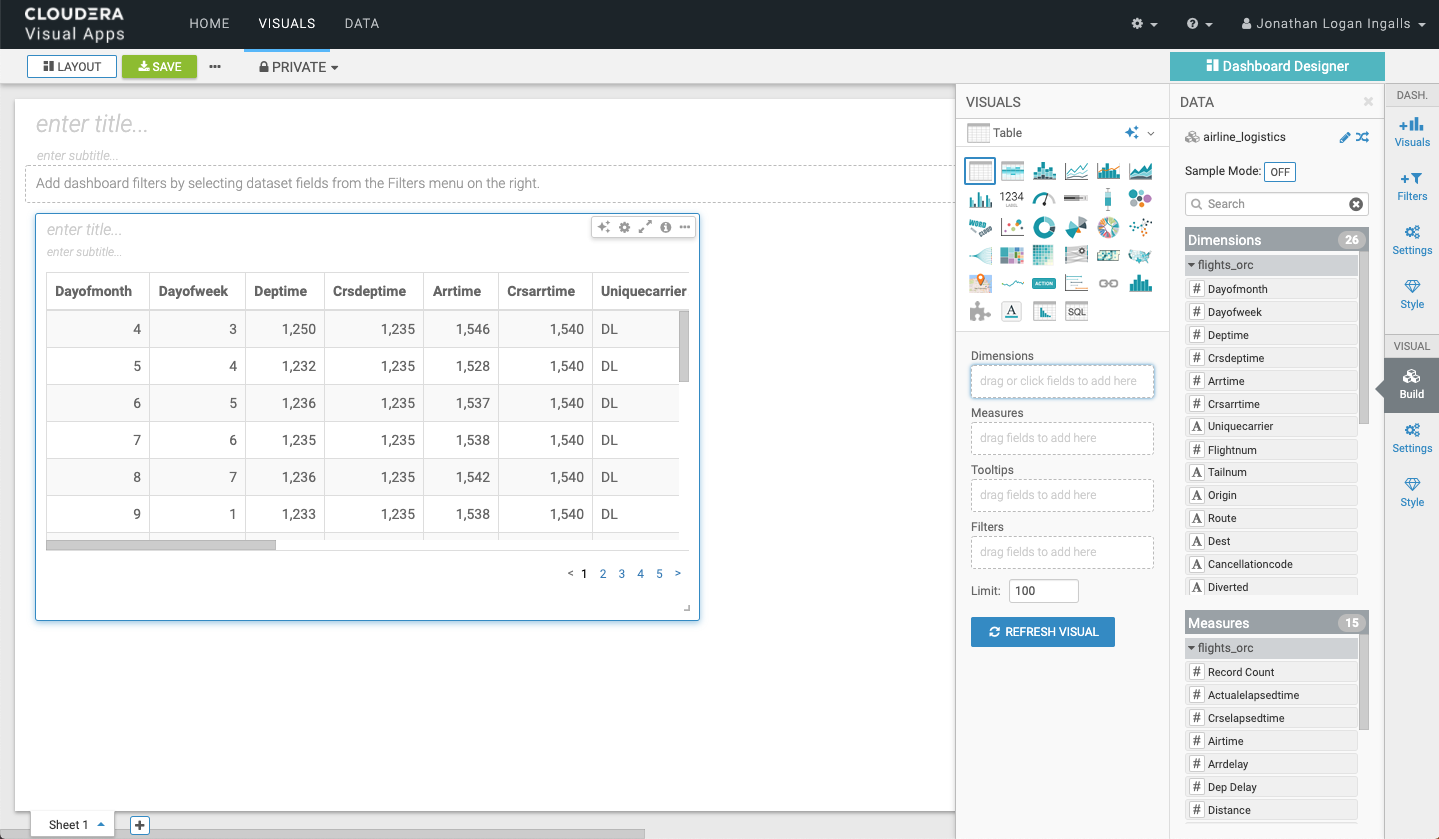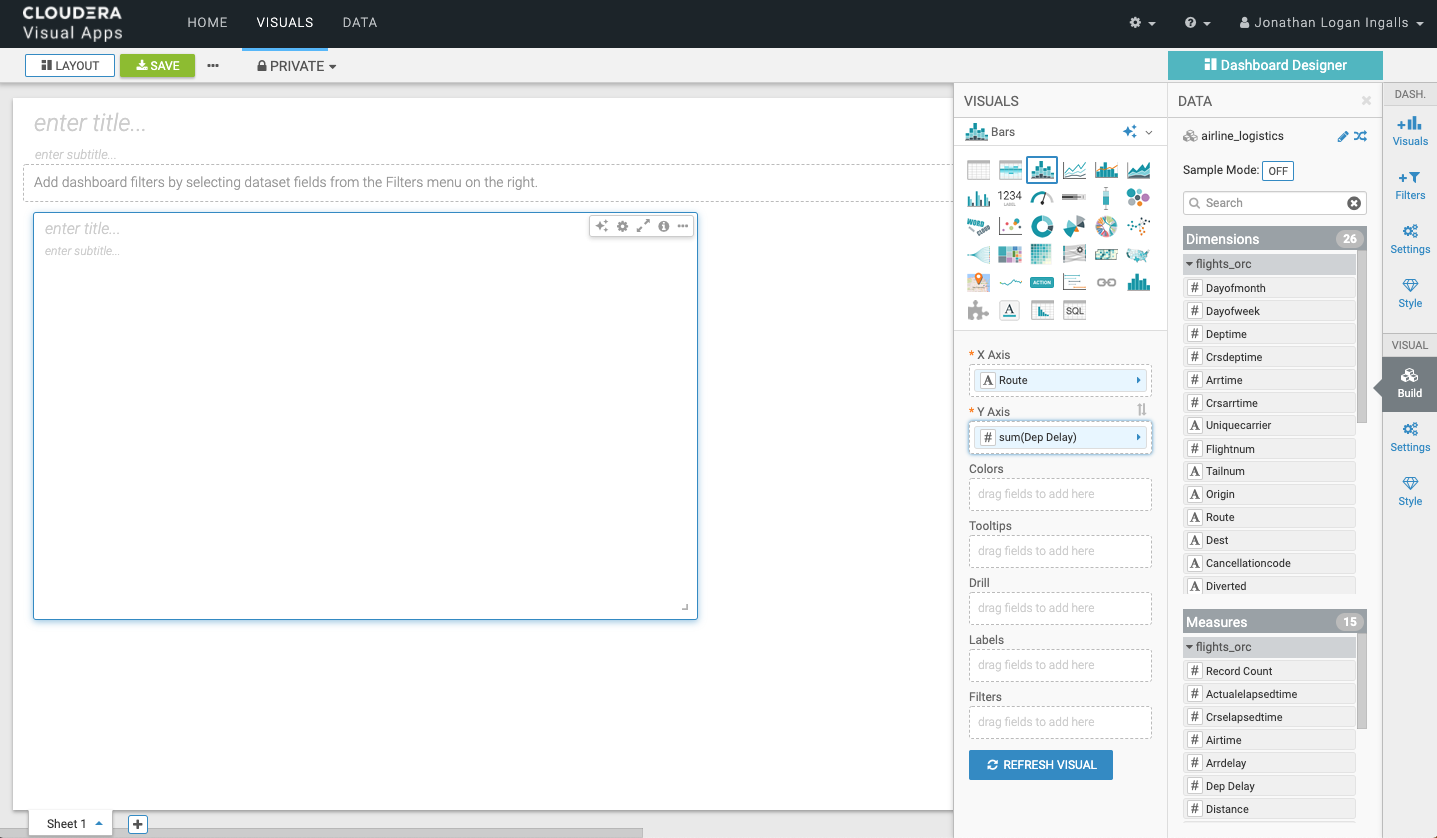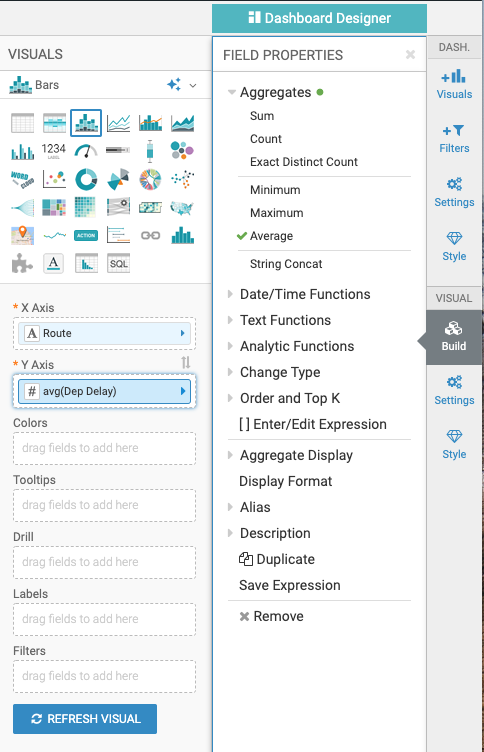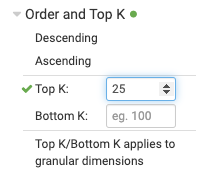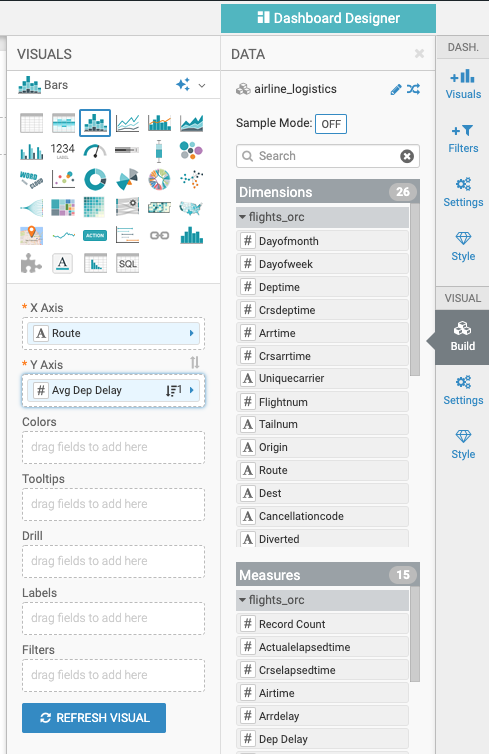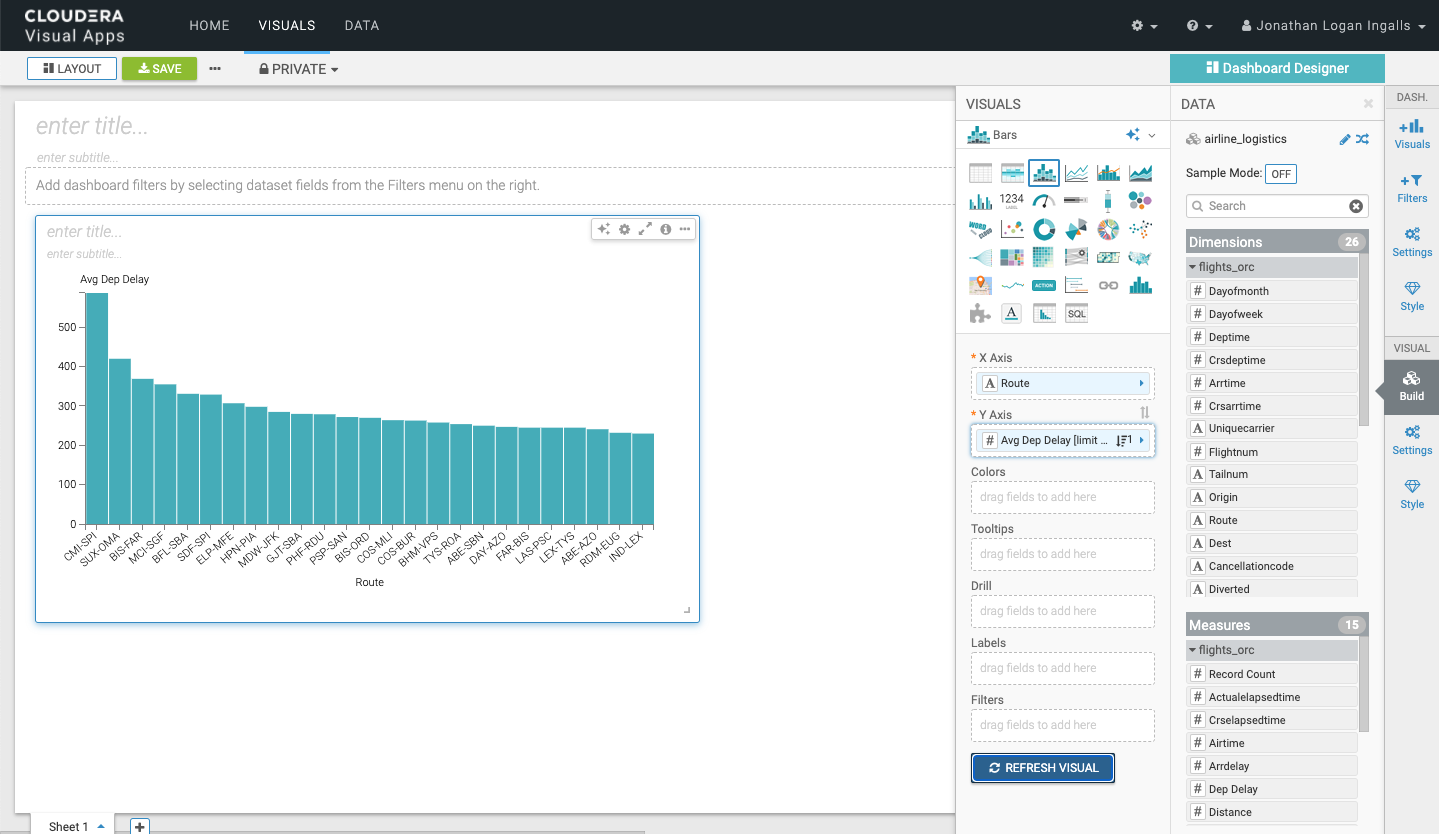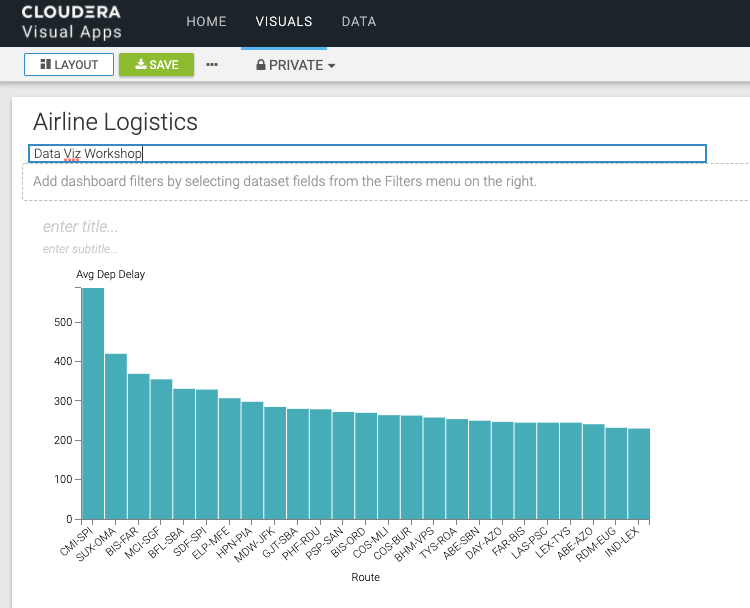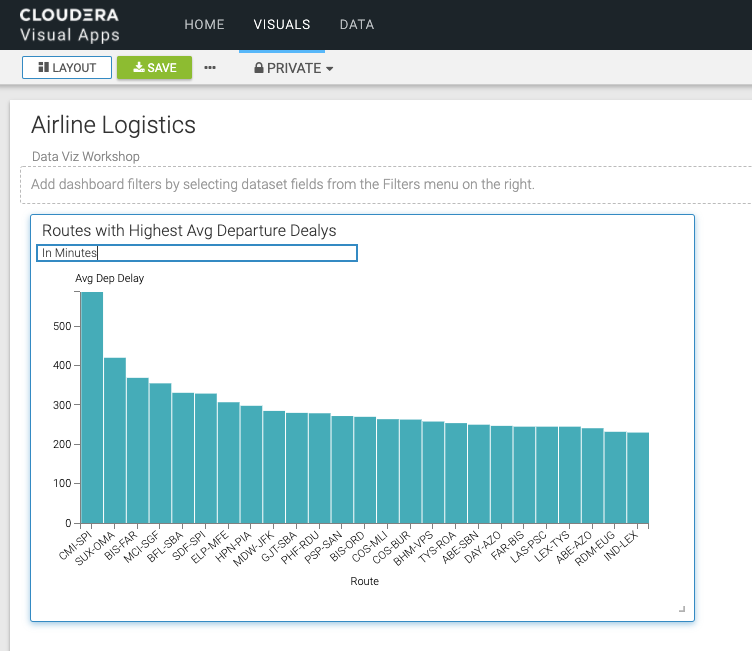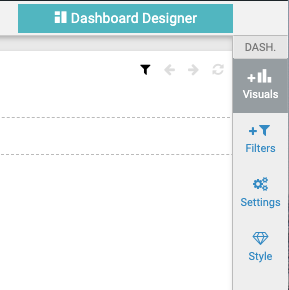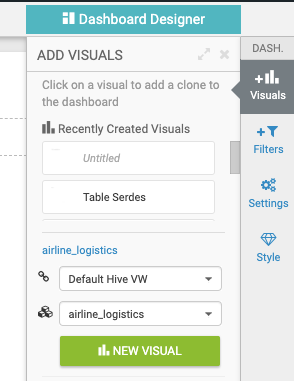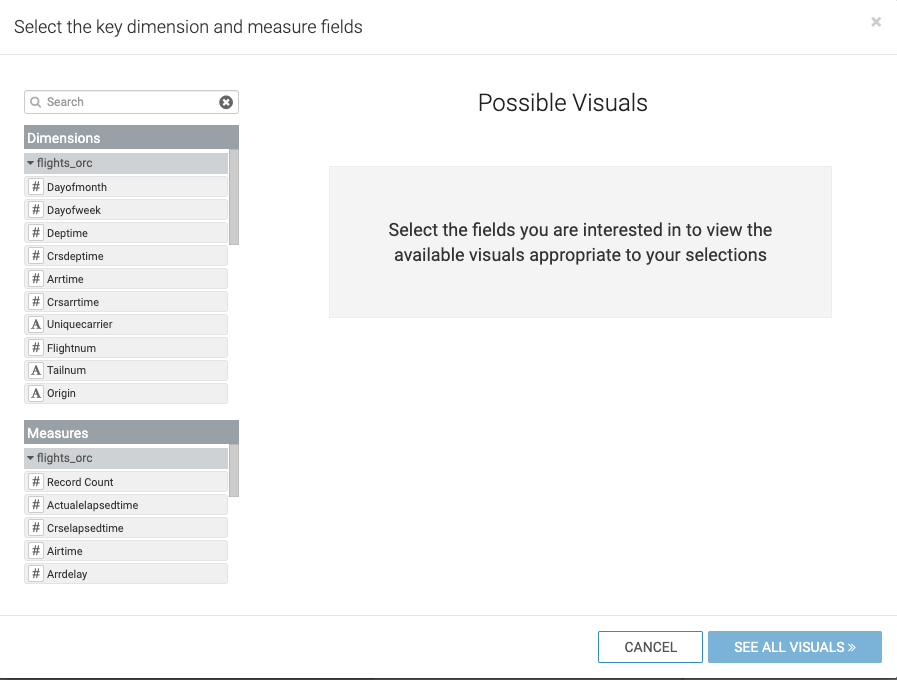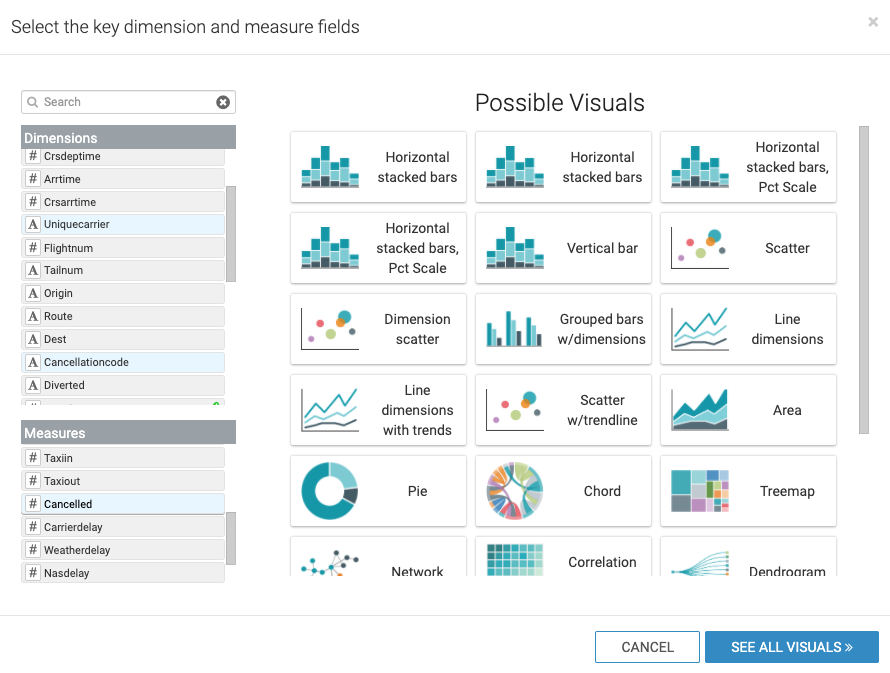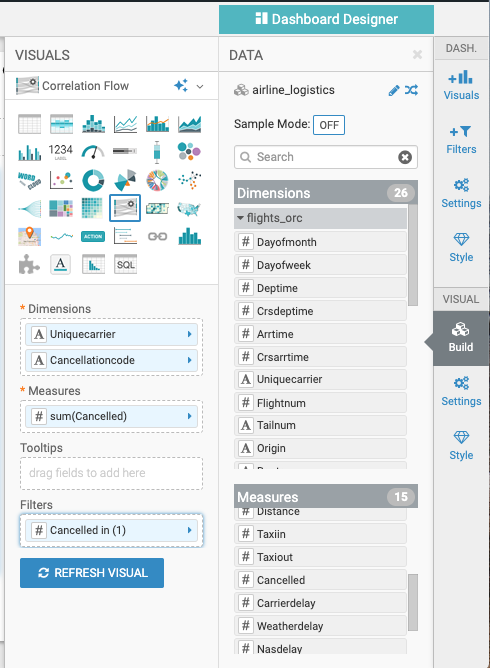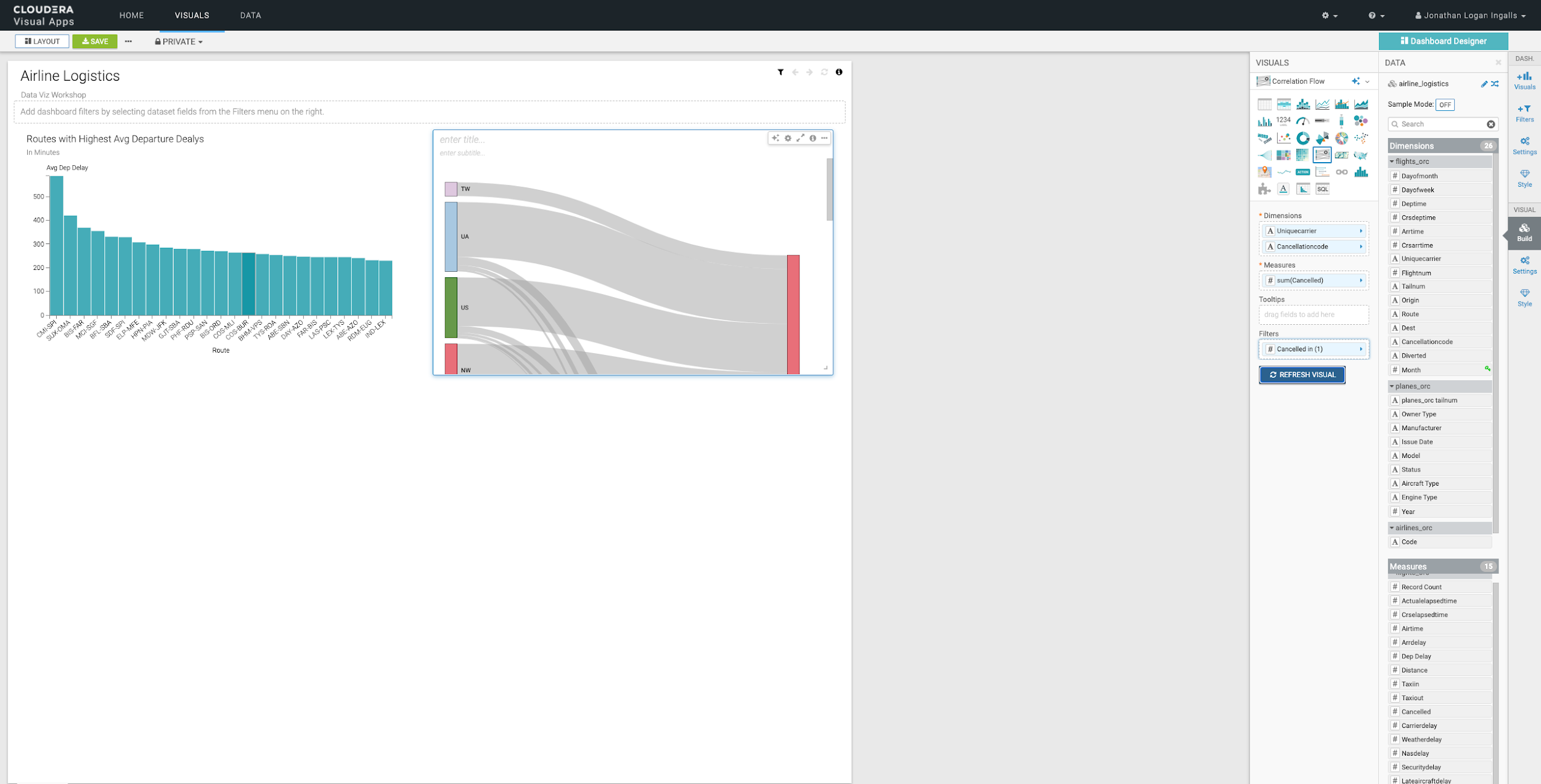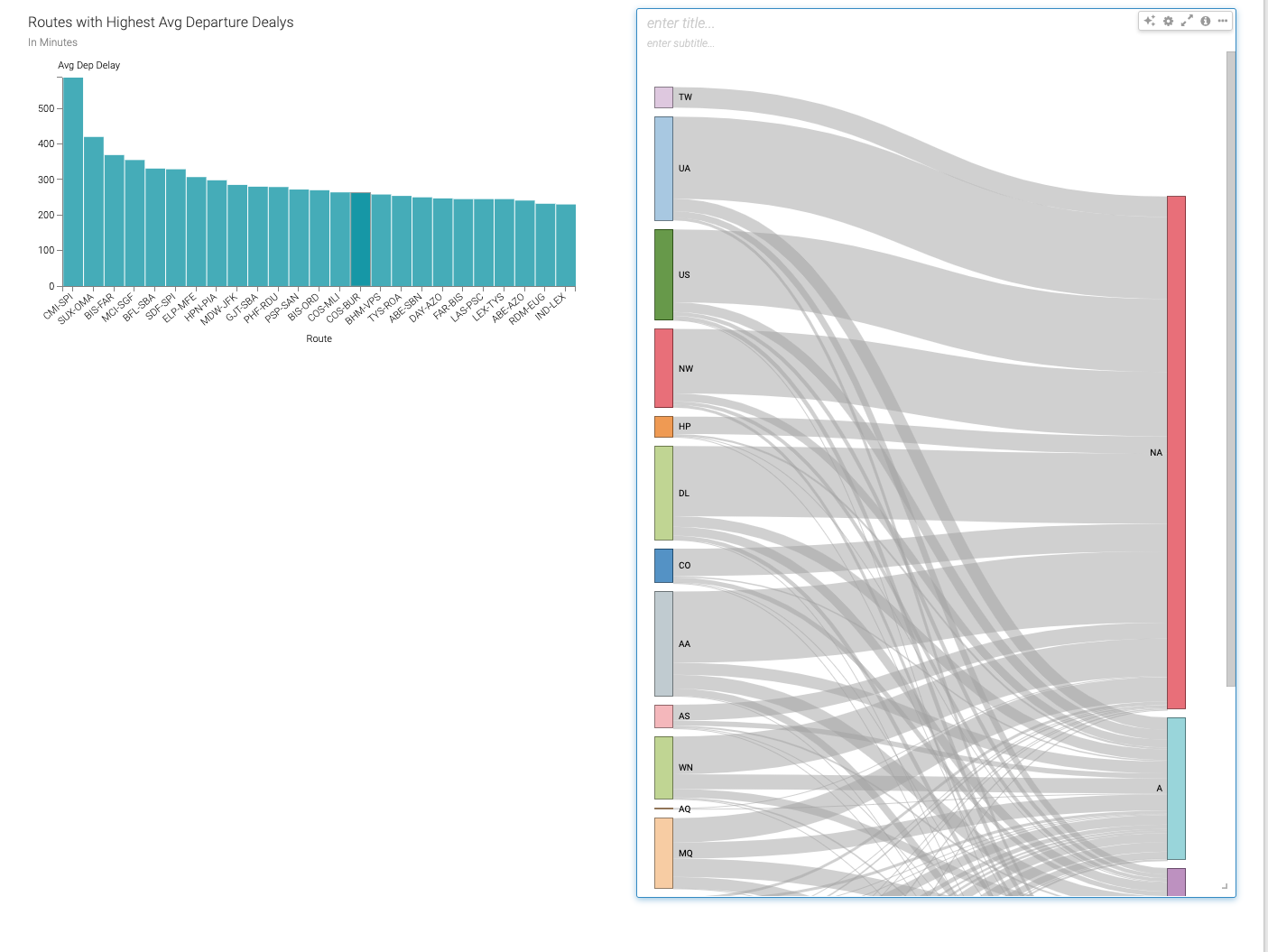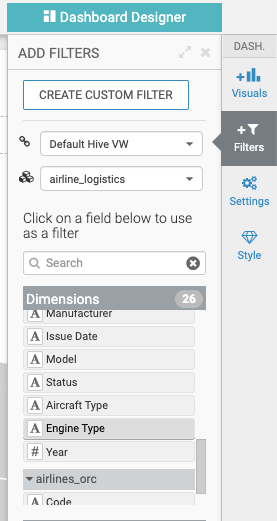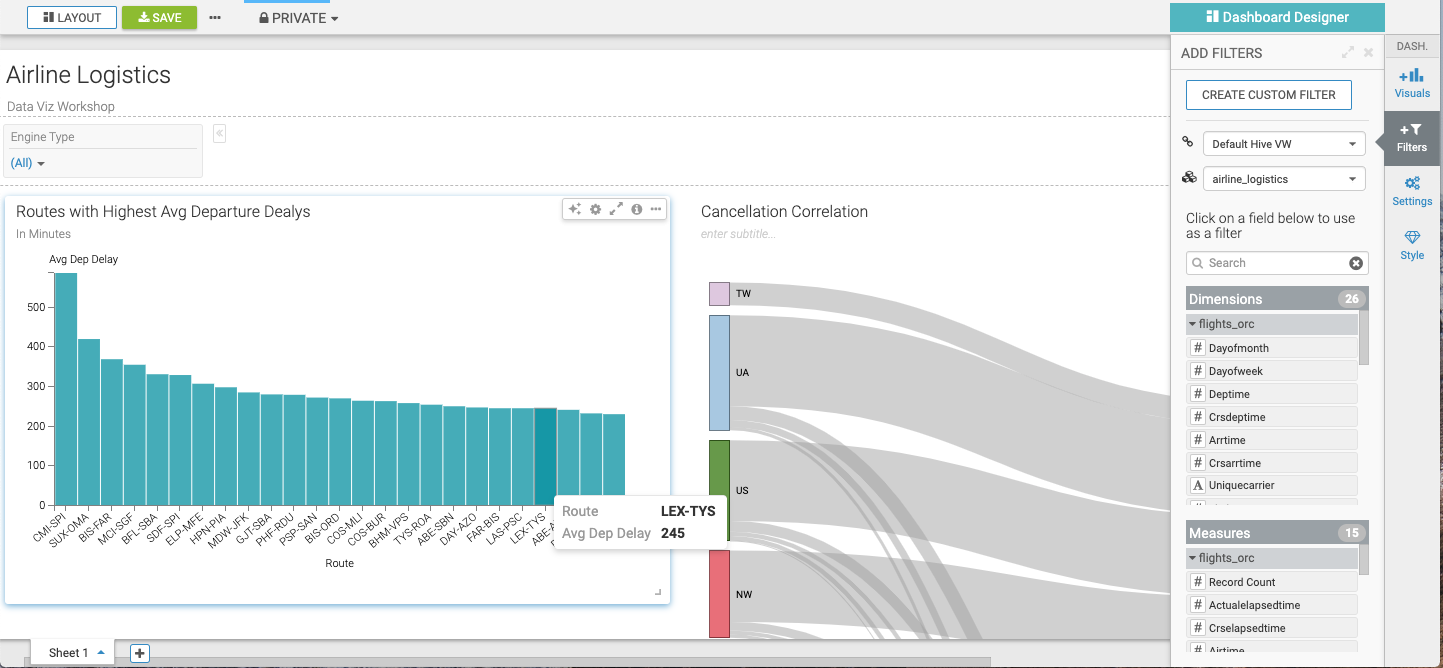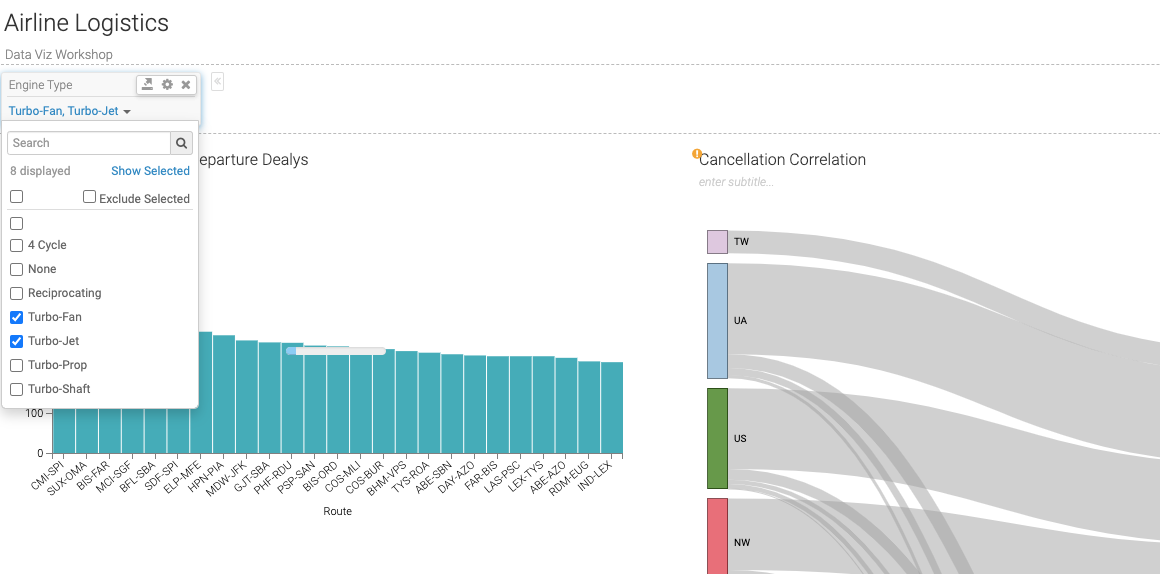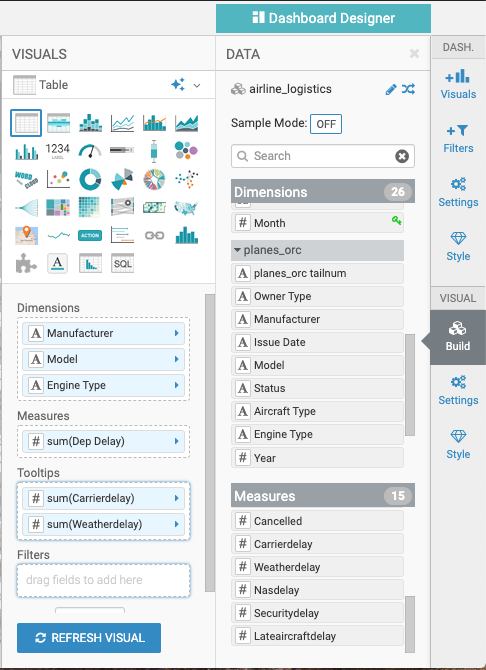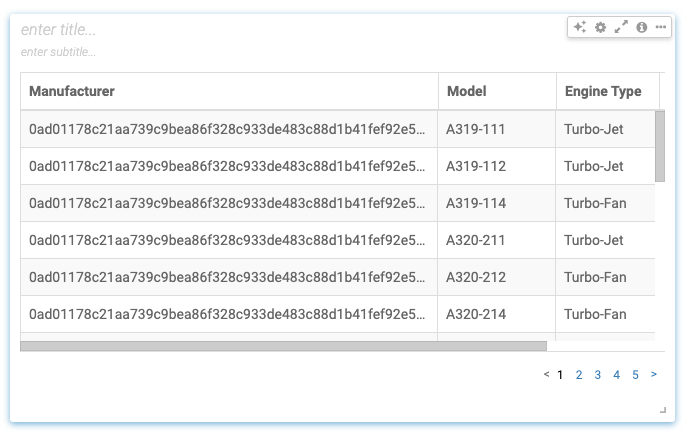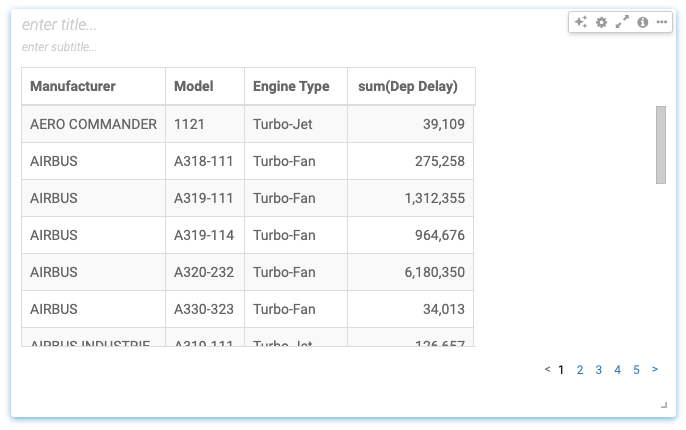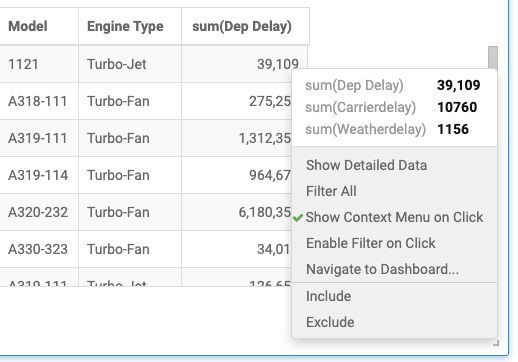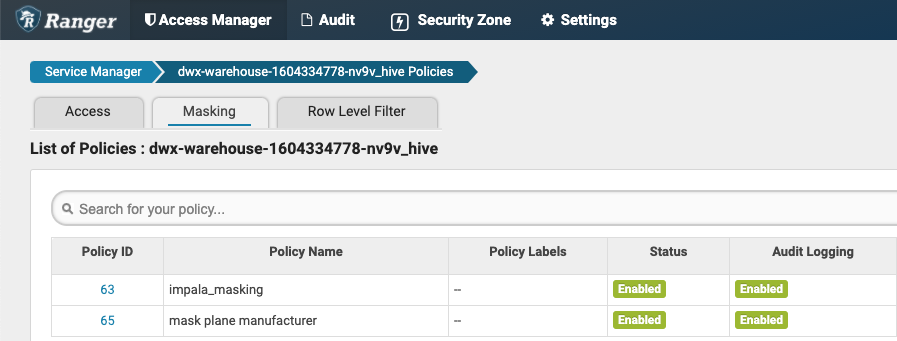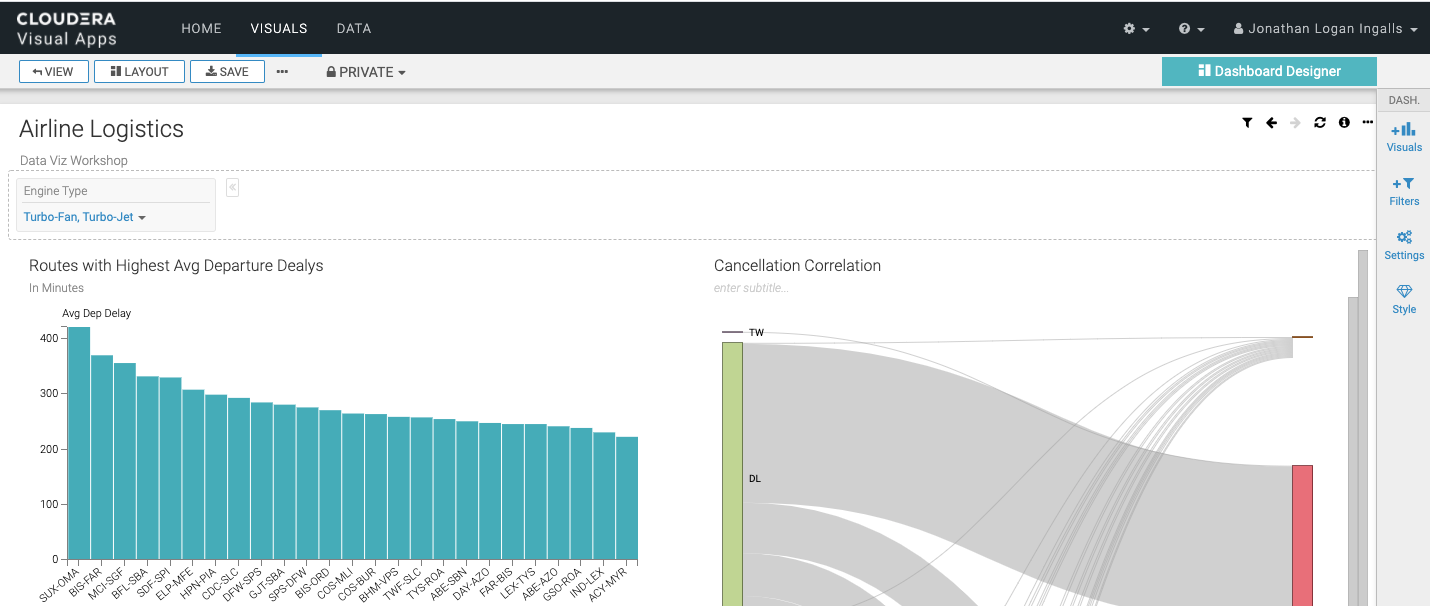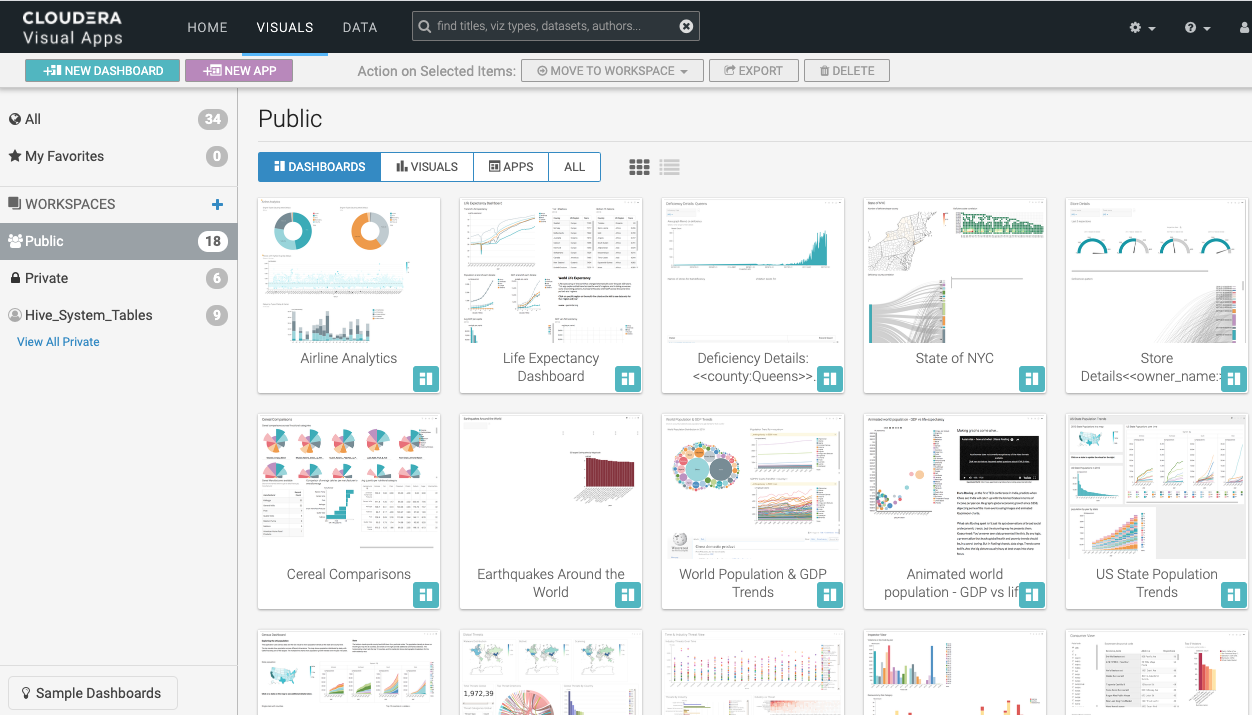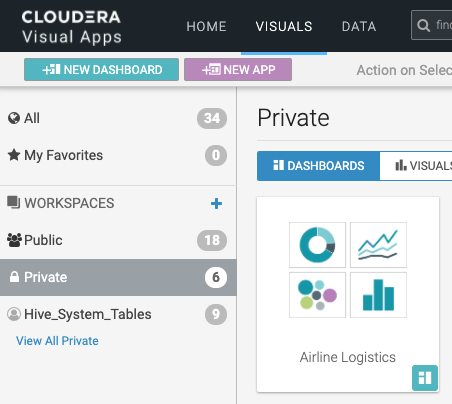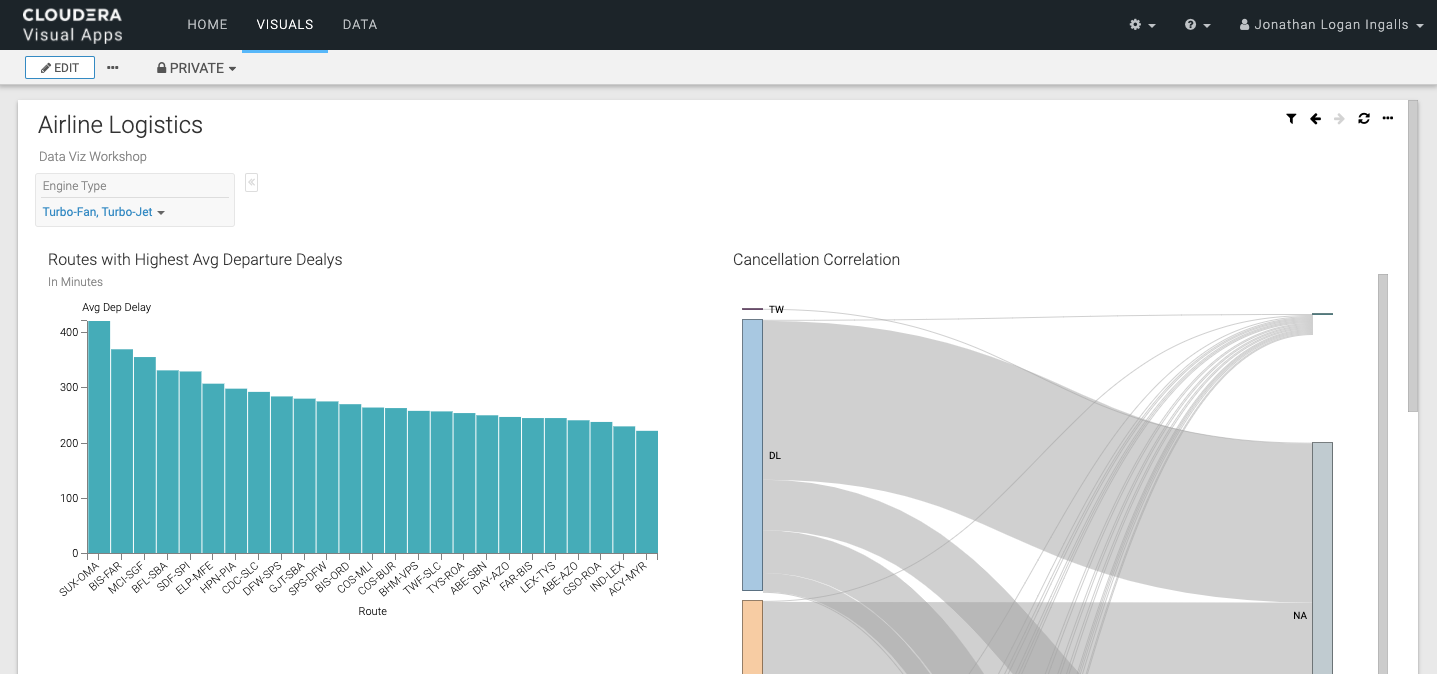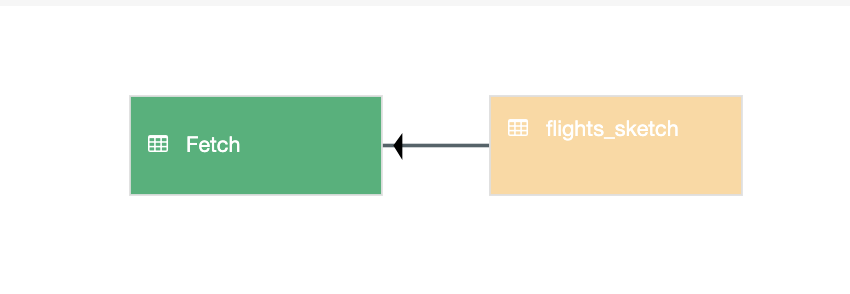Analyze Stored Data
This workshop gives you an overview of how to use the Cloudera Data Warehouse service to quickly explore raw data, create curated versions of the data for reporting and dashboarding, and then scale up usage of the curated data by exposing it to more users. It highlights the performance and automation capabilities that help ensure performance is maintained while controlling cost.
Enitiy-Relation Diagram of tables we use in todays workshop:
- fact table: flights (86mio rows)
- dimension tables: airlines (1.5k rows), airports (3.3k rows) and planes (5k rows)
You have to set your workload password.
- Click on username in the bottom left
- Click Profile
- Click “Set Workload Password” link
- Then enter and confirm the password
- Click “Set Workload Password”
Do all these steps as the “db_user001”..”db_user020” unless otherwise noted.
Navigate to Data Warehouse, then Virtual Warehouse and open the SQL Authoring tool DAS or HUE.
Create new database for your user to be used, or use one that is already created for you.
-- Change *** of database name
CREATE DATABASE DB_USER0**;
USE DB_USER0**;
Your can check your current database
select current_database();Run DDL to create four external tables on the CSV data files, which are already in cloud object storage.
drop table if exists flights_csv;
CREATE EXTERNAL TABLE flights_csv(month int, dayofmonth int,
dayofweek int, deptime int, crsdeptime int, arrtime int,
crsarrtime int, uniquecarrier string, flightnum int, tailnum string,
actualelapsedtime int, crselapsedtime int, airtime int, arrdelay int,
depdelay int, origin string, dest string, distance int, taxiin int,
taxiout int, cancelled int, cancellationcode string, diverted string,
carrierdelay int, weatherdelay int, nasdelay int, securitydelay int,
lateaircraftdelay int, year int)
ROW FORMAT DELIMITED FIELDS TERMINATED BY ',' LINES TERMINATED BY '\n'
STORED AS TEXTFILE LOCATION '/airlinedata-csv/flights' tblproperties("skip.header.line.count"="1");
drop table if exists planes_csv;
CREATE EXTERNAL TABLE planes_csv(tailnum string, owner_type string, manufacturer string, issue_date string, model string, status string, aircraft_type string, engine_type string, year int)
ROW FORMAT DELIMITED FIELDS TERMINATED BY ',' LINES TERMINATED BY '\n'
STORED AS TEXTFILE LOCATION '/airlinedata-csv/planes' tblproperties("skip.header.line.count"="1");
drop table if exists airlines_csv;
CREATE EXTERNAL TABLE airlines_csv(code string, description string) ROW FORMAT DELIMITED FIELDS TERMINATED BY ',' LINES TERMINATED BY '\n'
STORED AS TEXTFILE LOCATION '/airlinedata-csv/airlines' tblproperties("skip.header.line.count"="1");
drop table if exists airports_csv;
CREATE EXTERNAL TABLE airports_csv(iata string, airport string, city string, state DOUBLE, country string, lat DOUBLE, lon DOUBLE)
ROW FORMAT DELIMITED FIELDS TERMINATED BY ',' LINES TERMINATED BY '\n'
STORED AS TEXTFILE LOCATION '/airlinedata-csv/airports' tblproperties("skip.header.line.count"="1");
drop table if exists unique_tickets_csv;
CREATE external TABLE unique_tickets_csv (ticketnumber BIGINT, leg1flightnum BIGINT, leg1uniquecarrier STRING, leg1origin STRING, leg1dest STRING, leg1month BIGINT, leg1dayofmonth BIGINT,
leg1dayofweek BIGINT, leg1deptime BIGINT, leg1arrtime BIGINT,
leg2flightnum BIGINT, leg2uniquecarrier STRING, leg2origin STRING,
leg2dest STRING, leg2month BIGINT, leg2dayofmonth BIGINT, leg2dayofweek BIGINT, leg2deptime BIGINT, leg2arrtime BIGINT )
ROW FORMAT DELIMITED FIELDS TERMINATED BY ',' LINES TERMINATED BY '\n'
STORED AS TEXTFILE LOCATION '/airlinedata-csv/unique_tickets'
tblproperties("skip.header.line.count"="1");
Check that you created tables
SHOW TABLES;Results
| TAB_NAME |
|---|
| airlines_csv |
| airports_csv |
| flights_csv |
| planes_csv |
| unique_tickets_csv |
Run exploratory queries to understand the data. This reads the CSV data, converts it into a columnar in-memory format, and executes the query.
QUERY: Airline Delay Aggregate Metrics by Airplane
DESCRIPTION: Customer Experience Reporting showing airplanes that have the highest average delays, causing the worst customer experience.
Do all these steps in the “db_user001”..”db_user020” unless otherwise noted.
SELECT tailnum,
count(*),
avg(depdelay) AS avg_delay,
max(depdelay),
avg(taxiout),
avg(cancelled),
avg(weatherdelay),
max(weatherdelay),
avg(nasdelay),
max(nasdelay),
avg(securitydelay),
max(securitydelay),
avg(lateaircraftdelay),
max(lateaircraftdelay),
avg(airtime),
avg(actualelapsedtime),
avg(distance)
FROM flights_csv
GROUP BY tailnum
ORDER BY avg_delay DESC;Note: Runing the first time may take a clouple minutes.
Results
| TAILNUM | _C1 | AVG_DELAY | _C3 | _C4 | _C5 | _C6 | _C7 | _C8 | _C9 | _C10 | _C11 | _C12 | _C13 | _C14 | _C15 | _C16 |
|---|---|---|---|---|---|---|---|---|---|---|---|---|---|---|---|---|
| N702AW | 1 | null | null | 0.0 | 1.0 | 0.0 | 0 | 0.0 | 0 | 0.0 | 0 | 0.0 | 0 | null | null | 843.0 |
| N662?? | 1 | null | null | 0.0 | 1.0 | null | null | null | null | null | null | null | null | null | null | 528.0 |
| N043BR | 1 | null | null | 0.0 | 1.0 | 0.0 | 0 | 0.0 | 0 | 0.0 | 0 | 0.0 | 0 | null | null | 224.0 |
QUERY: Engine Types Causing Most Delays DESCRIPTION: Ad Hoc Exploration to Investigate - Exploratory query to determine which engine type contributes to the most delayed flights.
SELECT model,
engine_type
FROM planes_csv
WHERE planes_csv.tailnum IN
(SELECT tailnum
FROM
(SELECT tailnum,
count(*),
avg(depdelay) AS avg_delay,
max(depdelay),
avg(taxiout),
avg(cancelled),
avg(weatherdelay),
max(weatherdelay),
avg(nasdelay),
max(nasdelay),
avg(securitydelay),
max(securitydelay),
avg(lateaircraftdelay),
max(lateaircraftdelay),
avg(airtime),
avg(actualelapsedtime),
avg(distance)
FROM flights_csv
WHERE tailnum IN ('N194JB',
'N906S',
'N575ML',
'N852NW',
'N000AA')
GROUP BY tailnum) AS delays);
NOTE: If this returns no results, then remove the 'WHERE tailnum in …' clause
Results
| MODEL | ENGINE_TYPE |
|---|---|
| A330-223 | Turbo-Fan |
Run “CREATE TABLE AS SELECT” queries to create full ACID ORC type of the tables. This creates curated versions of the data which are optimal for BI usage.
Do all these steps in the “db_user001”..”db_user020” unless otherwise noted.
drop table if exists airlines_orc;
create table airlines_orc as select * from airlines_csv;
drop table if exists airports_orc;
create table airports_orc as select * from airports_csv;
drop table if exists planes_orc;
create table planes_orc as select * from planes_csv;
drop table if exists unique_tickets_orc;
create table unique_tickets_orc as select * from unique_tickets_csv;
drop table if exists flights_orc;
create table flights_orc partitioned by (year) as
select year, month, dayofmonth, dayofweek, deptime, crsdeptime, arrtime, crsarrtime, uniquecarrier, flightnum, tailnum, actualelapsedtime, crselapsedtime, airtime, arrdelay, depdelay, origin, dest, distance, taxiin, taxiout, cancelled, cancellationcode, diverted, carrierdelay, weatherdelay, nasdelay, securitydelay, lateaircraftdelay
from flights_csv;
This takes a few minutes!
Check that you created managed & external tables
USE DB_USER0**;
SHOW TABLES;Results
| TAB_NAME |
|---|
| airlines_csv |
| airlines_orc |
| airports_csv |
| airports_orc |
| flights_csv |
| flights_orc |
| planes_csv |
| planes_orc |
| unique_tickets_csv |
| unique_tickets_orc |
Experiment with different queries to see effects of the data cache on each executor.
Run query. Highlight both “SET …” and “SELECT …” when you execute.
SET hive.query.results.cache.enabled=false;
SELECT
SUM(flights.cancelled) AS num_flights_cancelled,
SUM(1) AS total_num_flights,
MIN(airlines.description) AS airline_name,
airlines.code AS airline_code
FROM
flights_orc flights
JOIN airlines_orc airlines ON (flights.uniquecarrier = airlines.code)
GROUP BY
airlines.code
ORDER BY
num_flights_cancelled DESC;Go to Queries page, then click on the query that just ran, then scroll down to DAG INFO, choose DAG COUNTERS, then filter for 'cache', then show CACHE_MISS_BYTES and/or CACHE_HIT_BYTES. Take note of the query run time too.
Note: sometimes it takes up to a few minutes for DAS to parse the query metrics and expose them in the UI.
Run query again. Check the cache metrics again to see the improved hit rate.
Query to find all international flights: flights where destination airport country is not the same as origin airport country
SELECT DISTINCT
flightnum,
uniquecarrier,
origin,
dest,
month,
dayofmonth,
`dayofweek`
FROM
flights_orc f,
airports_orc oa,
airports_orc da
WHERE
f.origin = oa.iata
and f.dest = da.iata
And oa.country <> da.country
ORDER BY
month ASC,
dayofmonth ASC;Query to explore passenger manifest data: do we have international connecting flights?
SELECT * FROM
unique_tickets_orc a,
flights_orc o,
flights_orc d,
airports_orc oa,
airports_orc da
WHERE
a.leg1flightnum = o.flightnum
AND a.leg1uniquecarrier = o.uniquecarrier
AND a.leg1origin = o.origin
AND a.leg1dest = o.dest
AND a.leg1month = o.month
AND a.leg1dayofmonth = o.dayofmonth
AND a.leg1dayofweek = o.`dayofweek`
AND a.leg2flightnum = d.flightnum
AND a.leg2uniquecarrier = d.uniquecarrier
AND a.leg2origin = d.origin
AND a.leg2dest = d.dest
AND a.leg2month = d.month
AND a.leg2dayofmonth = d.dayofmonth
AND a.leg2dayofweek = d.`dayofweek`
AND d.origin = oa.iata
AND d.dest = da.iata
AND oa.country <> da.country ; Number of passengers on the airline that has long, planned layovers for an international flight
SELECT
a.leg1uniquecarrier as carrier,
count(a.leg1uniquecarrier) as passengers
FROM
unique_tickets_orc a
where
a.leg2deptime - a.leg1arrtime>90
group by
a.leg1uniquecarrier;Do all these steps in the “db_user001”..”db_user020” unless otherwise noted.
Create materialized view (MV). This will cause Hive to transparently rewrite queries, when possible, to use the MV instead of the base tables.
Create Materialized View
DROP MATERIALIZED VIEW IF EXISTS traffic_cancel_airlines;
CREATE MATERIALIZED VIEW traffic_cancel_airlines
as SELECT airlines.code AS code, MIN(airlines.description) AS description,
flights.month AS month,
sum(flights.cancelled) AS cancelled
FROM flights_orc flights JOIN airlines_orc airlines ON (flights.uniquecarrier = airlines.code)
group by airlines.code, flights.month;Check that the Materialized view is created. Replace ** in DB_USER0**
SHOW MATERIALIZED VIEWS;Results
| MV_NAME | REWRITE_ENABLED | MODE |
|---|---|---|
| traffic_cancel_airlines | Yes | Manual refresh |
Running a dashoboard query
SET hive.query.results.cache.enabled=false;
SELECT airlines.code AS code, MIN(airlines.description) AS description,
sum(flights.cancelled) AS cancelled
FROM flights_orc flights , airlines_orc airlines
WHERE flights.uniquecarrier = airlines.code
group by airlines.code;Run the explain and query rewrite should show like:
Cloudera Iceberg is a high-performance format for huge analytic tables for engines like Spark, Impala Flink and Hive to safely work with the same tables, at the same time.
Creatint a partitioned table with CREATE TABLE ... PARTITIONED BY & STORED BY ICEBERG syntax enables you to create identity-partitioned Iceberg tables. Identity-partitioned Iceberg tables are similar to the regular partitioned tables and are stored in the same directory structure as the regular partitioned tables.
Lets create a new table with Iceberg format and insert rows in batches:
drop table if exists flights_ice;
create table flights_ice(month int, dayofmonth int,
dayofweek int, deptime int, crsdeptime int, arrtime int,
crsarrtime int, uniquecarrier string, flightnum int, tailnum string,
actualelapsedtime int, crselapsedtime int, airtime int, arrdelay int,
depdelay int, origin string, dest string, distance int, taxiin int,
taxiout int, cancelled int, cancellationcode string, diverted string,
carrierdelay int, weatherdelay int, nasdelay int, securitydelay int,
lateaircraftdelay int)
partitioned by (year int)
stored by ICEBERG;
insert into flights_ice
select month, dayofmonth, dayofweek, deptime, crsdeptime, arrtime, crsarrtime, uniquecarrier, flightnum, tailnum, actualelapsedtime, crselapsedtime, airtime, arrdelay, depdelay, origin, dest, distance, taxiin, taxiout, cancelled, cancellationcode, diverted, carrierdelay, weatherdelay, nasdelay, securitydelay, lateaircraftdelay, year
from flights_orc where year = 1995;
insert into flights_ice
select month, dayofmonth, dayofweek, deptime, crsdeptime, arrtime, crsarrtime, uniquecarrier, flightnum, tailnum, actualelapsedtime, crselapsedtime, airtime, arrdelay, depdelay, origin, dest, distance, taxiin, taxiout, cancelled, cancellationcode, diverted, carrierdelay, weatherdelay, nasdelay, securitydelay, lateaircraftdelay, year
from flights_orc where year not in (1995); No we all rows with three inserts in the table, and can show the snapshots.
First check the rows in the table.
select count(*) from flights_ice;Result should be are all 86 mil rows.
| _c0 |
|---|
| 86289323 |
Now you can check the table histroy, change the database name and run the command:
select * from DB_userXXX.flights_ice.history;You should see two snapshots of the table in the output, one for each insert.
| FLIGHTS.MADE_CURRENT_AT | FLIGHTS_ICE.SNAPSHOT_ID | FLIGHTS.PARENT_ID | FLIGHTS.IS_CURRENT_ANCESTOR |
|---|---|---|---|
| 2022-05-01 09:29:12.509 Z | 7097750832501567062 | null | true |
| 2022-05-01 09:56:21.464 Z | 5696129515471947086 | 7097750832501567062 | true |
You now can time travel to one of the versions using SYSTEM_VERSION or SYSTEM_TIME - pick the number of FLIGHTS_ICE.SNAPSHOT_ID from the first row and replace the XXXXXXXXXXXXXXX
set hive.vectorized.execution.enabled = false;
select year,count(*) from flights_ice
FOR SYSTEM_VERSION AS OF XXXXXXXXXXXXXXX
group by year order by year;Now we see the query returns subset of data from the first insert.
| _c0 |
|---|
| 5327435 |
| `` |
| Partition Evolution is a feature when table layout can be updated as data or queries change. |
With Iceberg’s hidden partition, a separation between physical and logical, users are not required to maintain partition columns.
Lets change the partition add YEAR & MONTH, and insert data for another year:
alter table flights_ice SET PARTITION SPEC (year,month);
insert into flights_ice
select month, dayofmonth, dayofweek, deptime, crsdeptime, arrtime, crsarrtime,
uniquecarrier, flightnum, tailnum, actualelapsedtime, crselapsedtime, airtime, arrdelay, depdelay,
origin, dest, distance, taxiin, taxiout, cancelled, cancellationcode, diverted, carrierdelay, weatherdelay,
nasdelay, securitydelay, lateaircraftdelay, 2022
from flights_orc where year = 1995; Now lets see the impact what the differnece is, lets run two queries and note the complete time:
Count the records for one year and month:
select year, month, count(1) from flights_ice where year = 1995 and month = 1 group by year, month; In Hue you can find the runtime at the end of the output:
INFO : Completed executing command(queryId=hive_20220427111723_1f126db0-84aa-4df6-b0a1-065a4f9001e4); Time taken: 3.966 seconds
select year, month, count(1) from flights_ice where year = 2022 and month = 1 group by year, month; INFO : Completed executing command(queryId=hive_20220427111723_1f126db0-84aa-4df6-b0a1-065a4f9001e4); Time taken: 0.466 seconds
This expample shows that the execution time is 1/10 massive decreased.
Do all these steps in the “db_user001”..”db_user020” unless otherwise noted.
We create a new SDC table airline_scd and add columns valid_from and valid_to. Then loading the initial 1000 rows into this SDC table, then mock up new data and change data in the table airlines_stage.
Finally merging these two tables with a single MERGE command to maintain the historical data and check the results.
Create the Hive managed table for airlines. Load initial by copy 1000 rows of current airlines with hard code the valid_from date
drop table if exists airlines_scd;
create table airlines_scd(code string, description string, valid_from date, valid_to date);
insert into airlines_scd
select *, cast('2021-01-01' as date), cast(null as date)
from airlines_csv limit 1000;Create an external staging table pointing to our complete airlines dataset (1491 records) and update a description to mockup a change in the dimension
drop table if exists airlines_stage;
create table airlines_stage as select * from airlines_csv;
update airlines_stage set description =concat('Update - ',upper(description))
where code in ('02Q','04Q');Perform the SCD type 2 Merge Command
merge into airlines_scd
using (
-- The base staging data.
select
airlines_stage.code as join_key,
airlines_stage.* from airlines_stage
union all
-- Generate an extra row for changed records.
-- The null join_key means it will be inserted.
select
null, airlines_stage.*
from
airlines_stage join airlines_scd on airlines_stage.code = airlines_scd.code
where
( airlines_stage.description <> airlines_scd.description )
and airlines_scd.valid_to is null
) sub
on sub.join_key = airlines_scd.code
when matched
and sub.description <> airlines_scd.description
then update set valid_to = current_date()
when not matched
then insert values (sub.code, sub.description, current_date(), null);View the changed records and see that the VALID_FROM and VALID_TO dates are set
select * from airlines_scd where code in ('02Q','04Q') order by code, valid_from;Results
| CODE | DESCRIPTION | VALID_FROM | VALID_TO |
|---|---|---|---|
| 02Q | Titan Airways | 2021-01-01 | 2021-05-26 |
| 02Q | Update - TITAN AIRWAYS | 2021-05-26 | null |
| 04Q | Tradewind Aviation | 2021-01-01 | 2021-05-26 |
| 04Q | Update - TRADEWIND AVIATION | 2021-05-26 | null |
The combination of the Data Warehouse with SDX offers a list of powerful features like rule-based masking columns based on a user’s role and/or group association or rule-based row filters.
For this workshop we are going to explore Attribute-Based Access Control a.k.a. Tage-based security policies.
First we are going to create a series of tables in your work database.
In the SQL editor, select your database and run this script:
CREATE TABLE emp_fname (id int, fname string);
insert into emp_fname(id, fname) values (1, 'Carl');
insert into emp_fname(id, fname) values (2, 'Clarence');
CREATE TABLE emp_lname (id int, lname string);
insert into emp_lname(id, lname) values (1, 'Rickenbacker');
insert into emp_lname(id, lname) values (2, 'Fender');
CREATE TABLE emp_age (id int, age smallint);
insert into emp_age(id, age) values (1, 35);
insert into emp_age(id, age) values (2, 55);
CREATE TABLE emp_denom (id int, denom char(2));
insert into emp_denom(id, denom) values (1, 'rk');
insert into emp_denom(id, denom) values (2, 'na');
CREATE TABLE emp_id (id int, empid integer);
insert into emp_id(id, empid) values (1, 1146651);
insert into emp_id(id, empid) values (2, 239125);
CREATE TABLE emp_all as
(select a.id, a.fname, b.lname, c.age, d.denom, e.empid from emp_fname a
inner join emp_lname b on b.id = a.id
inner join emp_age c on c.id = b.id
inner join emp_denom d on d.id = c.id
inner join emp_id e on e.id = d.id);
create table emp_younger as (select * from emp_all where emp_all.age <= 45);
create table emp_older as (select * from emp_all where emp_all.age > 45);After this script executes, a simple
select * from emp_all;… should give the contents of the emp_all table, which only has a couple of lines of data.
For the next step we will switch to the UI of Atlas, the CDP component responsible for metadata management and governance: in the Cloudera Data Warehouse Overview UI, select your Virtual Warehouse to highlight the associated Database Catalog. Click on the three-dot menu of this DB catalog and select “Open Atlas” in the associated pop-up menu:
This should open the Atlas UI. CDP comes with a newer, improved user interface which can be enabled through the “Switch to Beta” item in the user menu on the upper right corner of the screen. Do this now.
The Atlas UI has a left column which lists the Entities, Classifications, Business Metadata and Glossaries that belong to your CDP Environment.
We just created a couple of tables in the Data Warehouse, let’s look at the associated metadata. Under “Entities”, click on “hive_db”. This should produce a list of databases. Select you workshop database, this will result in the database’s metadata being displayed.
Select the “Tables” tab (the rightmost)
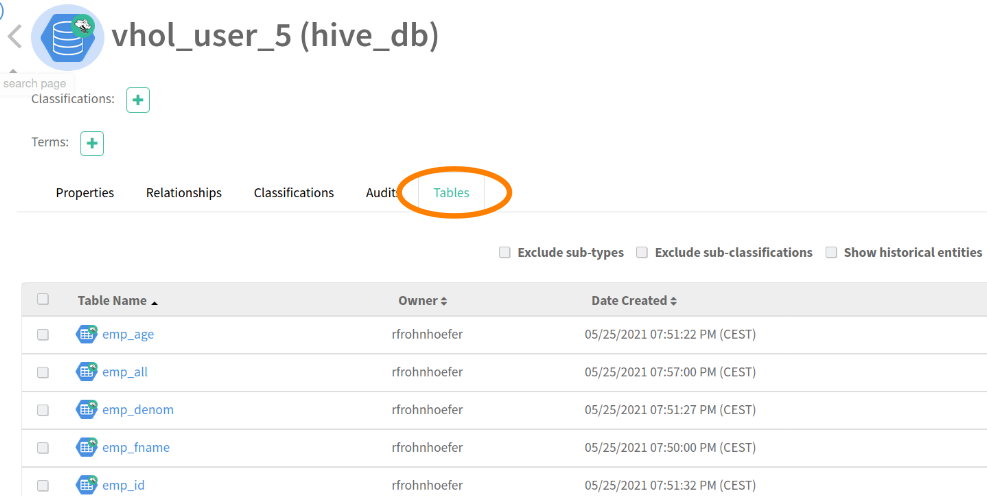
Select the “emp_all” table from the list, this will result in Atlas displaying the metadata for this table; select the “lineage” tab:
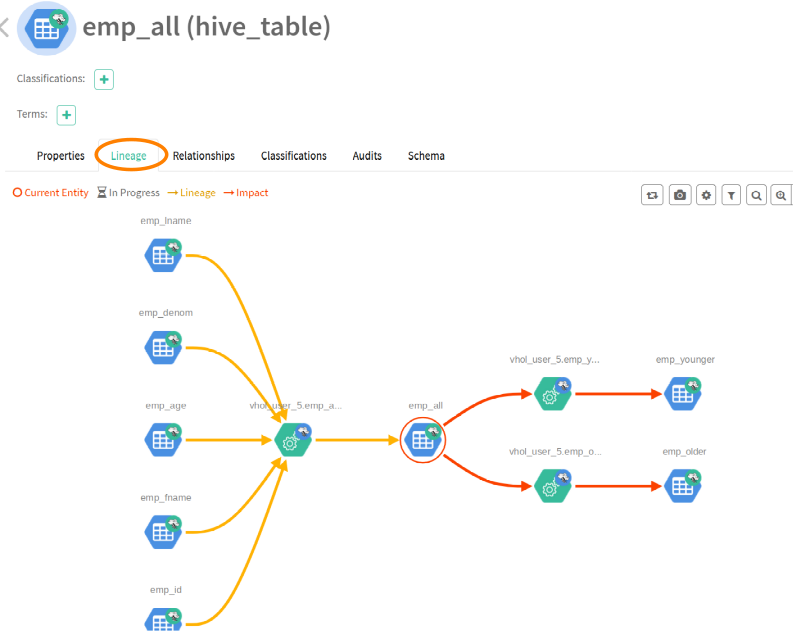 This lineage graph shows the inputs, outputs as well as the processing steps resulting from the execution of our SQL code in the Data Warehouse.
This lineage graph shows the inputs, outputs as well as the processing steps resulting from the execution of our SQL code in the Data Warehouse.
The red circle marks the currently selected entity. Atlas will always display the current entity's type in braces next to the entity name (middle, top of the page, e.g. "hive_table"). Clicking on one of the nodes will display a popup menu, which allows us to navigate through the lineage graph.
Click on the “emp_age” input table and select the link (the “guid” attribute) in the resulting popup menu:
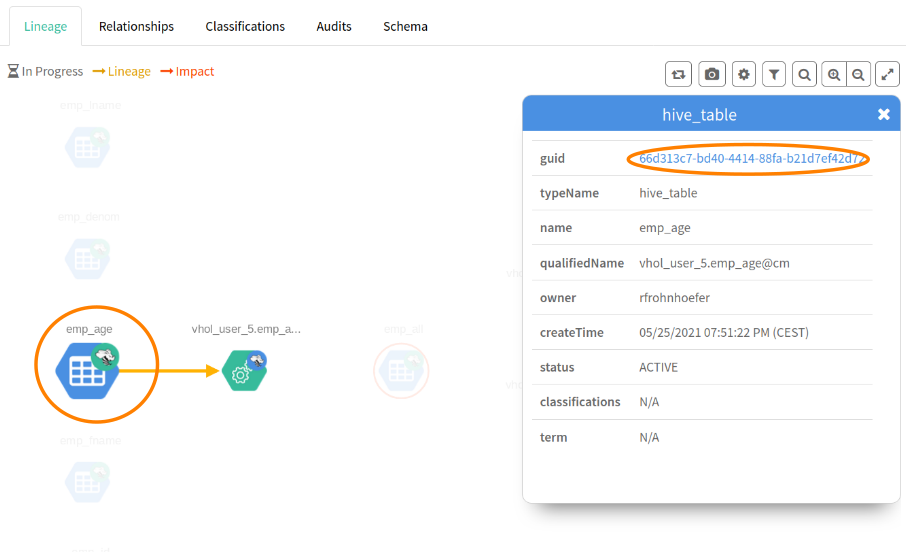
In the screen that follows, select the “Schema” tab and in that table, click on the link for the “age” field:
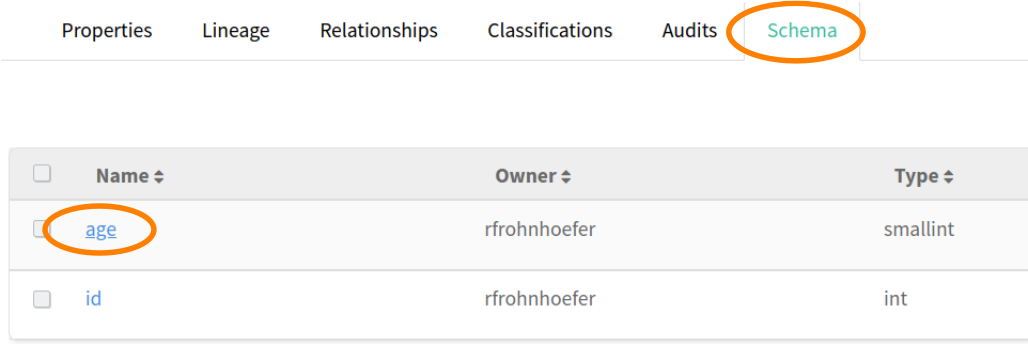
[Explanation: we are now looking at the metadata page for the “age” column of the “emp_age” table. There’s also a lineage tab here, because CDP tracks table- as well as column-based lineage for the Data Warehouse. What we want to do here: age is certainly a piece of sensitive personal information. We want to classify (‘tag’) it appropriately and then let SDX take care of treating this field as classified information that’s not visible to everyone.]
Still in the screen for the “age” column, click on the plus sign next to “Classifications”; this will bring up a dialog:
In the drop-down menu, select “PII” and make sure the “Propagate” checkbox is enabled. Click the “Add” button. [This effectively means we apply the classification “PII” to the selected column and Atlas also will apply that classification to all columns that have been or will be derived from it.]
We can actually check this easily by using the lineage graph to navigate to a downstream table’s column: select one of the nodes that don’t have gear wheels (those are process information) and select the guid link.
This will give us the metadata for the “age” column in a derived table. Note the information on “Propagated Classifications”:
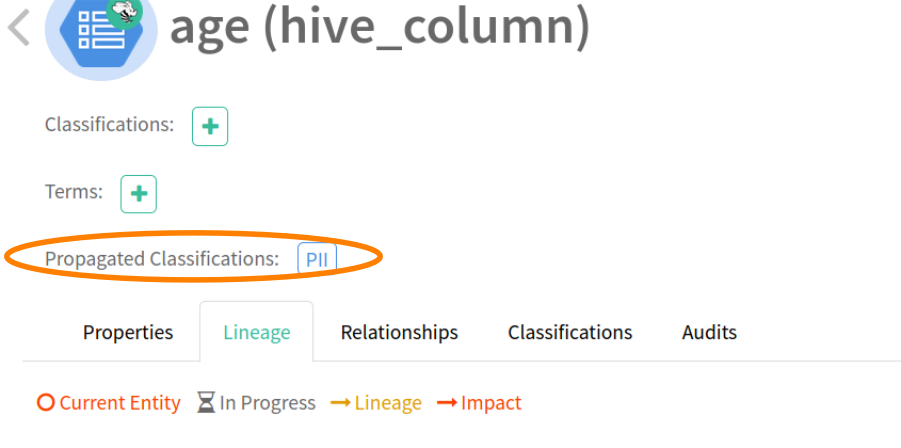 Try to query all columns from the “emp_all” table again in DAS – by simply executing the last query again.
Why did we get an error now? There exists a policy in Ranger that denies all members of the hands-on lab group access to Hive data that is classified as “PII”. Let’s check that out. Like before for Atlas, open the Ranger UI via the triple-dot menu in you warehouse’s Database Catalog:
Try to query all columns from the “emp_all” table again in DAS – by simply executing the last query again.
Why did we get an error now? There exists a policy in Ranger that denies all members of the hands-on lab group access to Hive data that is classified as “PII”. Let’s check that out. Like before for Atlas, open the Ranger UI via the triple-dot menu in you warehouse’s Database Catalog: 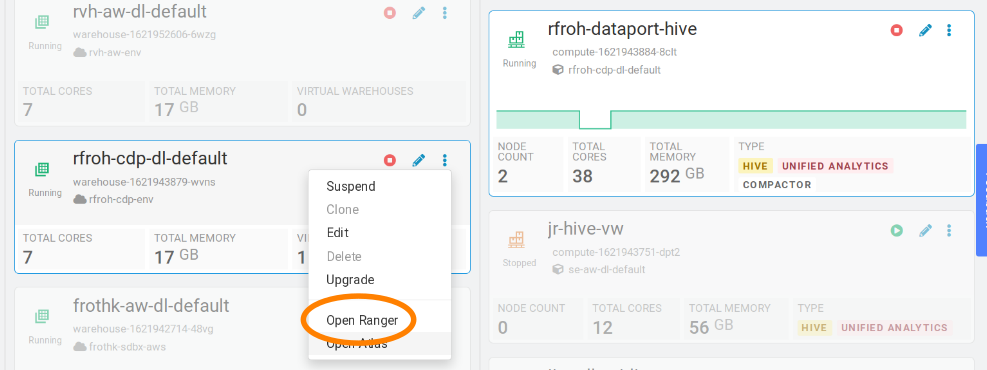
In the Ranger UI, select the “Audit” menu and limit the amount of data displayed by specifying the filter expressions: Result: Denied Service Type: HADOOP SQL
- Use Data Visualization to further explore the data set.
Open DataViz
| Step | Description |
|---|---|
| 1 | SSO login as user with password (not prompted) |
| 2 | Overview |
| 3 | Switch to Data Tab Initially will have no Data Models |
| 4 | Upload Data - will create new table within the Database that you are connected to Don’t need to execute this steps, but is great to show for Self Service analytics (Data Scientists & Data Analy sts |
| 5 | Build Data Model Create the Semantic Layer - data is not copied |
| 6 | Select Table or use SQL
Ability to add as a table or enter your own pre-defined SQL |
| 7 | Edit Data Model |
| 8 | Show Fields quickly Can see that it created fields for each column in the table that was selected. |
| 9 | Join Planes table with Flights table |
| 10 | Join Airlines table with Flights table |
| 11 | Preview Data Scroll right |
| 12 | Edit Fields Before You’ll use the following: Edit Field properties Create New Field Change Display Name to “Route” Edit Expression Expression: concat( [origin],'-', [dest]) Can Validate (to check for any errors) or Click Apply (to accept changes) |
| 13 | Finished Data Model Click Save |
| 14 | Create Dashboard |
| 15 | First Visual Change Dep Delay Aggregate to Average Change to only show Top 25 Avgs Change Alias Finished Refresh Visual Add Title & Subtitle for Dashboard Add Title & Subtitle for this chart |
| 16 | Second Visual Use Visual Styles to suggest charts Select UniqueCarrier, Cancellationcode, Cancelled Filter for only cancelled flights Resize (make larger) Add Chart Title - “Cancellation Correlation” |
| 17 | Add Prompts Select values from prompt |
| 18 | Third Visual (optional) Depending on user being used you may see the actual data not hashed (would need to login as Analyst user, and view this dashboard) or View Tooltips (click Dep Delay value) Use to show the Ranger security policy taking effect |
| 19 | Save Dashboard |
| 20 | View Dashboard Click on Dashboard |
Run load test to simulate adding many more end users. Then view results of autoscaling. Discuss how autoscaling works, and how it allows for easy, cost-effective scaling.
| -- Optional step. Can be just a discussion if no load test is actually done. |
|---|
Discuss how workload aware autoscaling runs ETL style queries on dedicated executor group to not interfere with shorter queries.
-- Start the creation process for a Hive VW and see the “Query Isolation” option. -- No need to continue to create the VW. |
|---|
Clean Up
DROP DATABASE DBB_USER0** CASCADE;This HPLSQL Package run a analyse by airport and list the top delayed flights in one single field (denormalized).
SQL Procedures Script - copy and paste to Hue
use airlinedata;
create or replace package airport_experience AS
MAX_FLIGHTS int := 3;
procedure describe();
procedure dbg (debug_level integer, msg string);
procedure total_arrival_delay ( IN v_iata string, OUT v_top_flights string, OUT v_totaldelay double);
procedure generate( v_airports varchar default 'JFK');
END;
create or replace package body airport_experience AS
procedure describe () is
begin
dbms_output.put_line('Package airport_experiences');
dbms_output.put_line('Version: 0.0.1');
dbms_output.put_line('Collection of prodecures to calcluate airpoort experience')
dbms_output.put_line('prodecures : generate () no parameter')
dbms_output.put_line('result set : table : airport_experiences')
end;
procedure dbg (debug_level integer, msg string)
is
BEGIN
declare ts string default SYSDATE;
declare lvl string default 'INFO';
if debug_level > 0
Begin
if debug_level > 10 SET lvl := 'ERROR';
DBMS_OUTPUT.PUT_LINE( ts || ':' ||lvl|| ': ' || msg);
end;
EXCEPTION WHEN OTHERS THEN
dbg(99,'Error: procedure dbg');
end;
procedure total_arrival_delay ( IN v_iata string, OUT v_top_flights string, OUT v_totaldelay double)
is
BEGIN
declare debug_level integer default 1;
declare v_flight string default '';
declare v_sum_delay double;
declare i int default 0;
declare v_d double;
DECLARE cur CURSOR FOR SELECT concat(uniquecarrier, flightnum) as flight_num, sum(arrdelay) as sum_delay
from flights_orc
where origin = v_iata
group by concat(uniquecarrier,flightnum)
having sum(arrdelay) is not null
order by sum_delay DESC;
dbg(debug_level, 'pro: total_arriaval_delay v_iata value: ' || v_iata || ' v_arrdelay: '||v_arr_delay );
v_top_flights = '';
select nvl(sum(arrdelay),0) into v_totaldelay
from flights_orc
where origin = v_iata;
dbg(debug_level, 'pro: fetch total delay value: ' || v_totaldelay );
if v_totaldelay <> 0 then
begin
dbg(debug_level, 'pro: delays found');
OPEN cur;
dbg(debug_level,'pro: cursor open');
FETCH cur INTO v_flight, v_sum_delay;
WHILE SQLCODE=0 and i < MAX_FLIGHTS THEN
set i := i + 1;
dbg(debug_level,'pro: fetched to ' || i || ' flight : ' || v_flight );
SET v_top_flights = v_top_flights || v_flight ||':'||v_sum_delay||';'
FETCH cur INTO v_flight, v_sum_delay;
END WHILE;
CLOSE cur;
end;
else
begin
dbg(debug_level,'pro: no delays found ');
v_totaldelay = 0;
end;
end if;
dbg( debug_level,'end: top_flights: '||v_top_flights);
EXCEPTION WHEN OTHERS THEN
dbg(99,'OTHERS: total_arrival_delay()');
END;
procedure generate( v_airports varchar default 'JFK')
IS
BEGIN
DECLARE debug_level integer default 1;
DECLARE v_iata string default 'JFK';
DECLARE v_top string default '#';
DECLARE v_total double default 0;
DECLARE v_c char;
DECLARE ts timestamp;
DECLARE v_msg string default '';
dbg(debug_level, 'main: 1 airports ' || v_airports);
select "'" into v_c;
DECLARE cur CURSOR FOR 'SELECT iata from airports_orc where iata in ( ' || v_c || v_airports || v_c || ')';
dbg(debug_level, 'main: 1');
OPEN cur;
dbg(debug_level,'main: 2 - cursor open');
FETCH cur INTO v_iata;
WHILE SQLCODE=0 THEN
v_top = '#';
v_total = 0;
dbg(debug_level,'main: 3 fetch - iata: ' || v_iata) ;
call total_arrival_delay(v_iata,v_top,v_total );
dbg(debug_level, 'main: 4 called proc total_arrival_delay ');
v_msg = 'airport:'||v_iata|| ' top flights: '|| v_top ||' total delay:'||v_total;
dbg(debug_level, 'main: 4 IN_OUT '||v_msg);
if v_total > 0.0
BEGIN
insert into airports_experiences values( v_iata, v_top, v_total);
dbg(debug_level, 'main: 5 row inserted with SQLCODE '|| SQLCODE );
END;
FETCH cur INTO v_iata;
END WHILE;
CLOSE cur;
dbg(debug_level ,'main: 5 - finished');
EXCEPTION WHEN OTHERS THEN
dbg(99,'Error: main');
END;
end;
Open Hue HPL/SQL Editor and create the above package.
Now run the Analytics for a individual airport
drop table if exists airports_experiences;
create table airports_experiences(iata string, delay_top_flights string, delay_total double ) ;
begin
CALL airport_experience.describe();
CALL airport_experience.generate( 'SFO');
CALL airport_experience.generate( 'JFK');
CALL airport_experience.generate( 'BOS');
end;
select * from airports_experiences;
Results
| airports_stats.iata | airports_stats.delay_top_flights | airports_stats.delay_total |
|---|---|---|
| JFK | AA647:91067.0;AA177:87305.0;AA1639:82770.0; | 1.0155716E7 |
| LAX | DL1579:68519.0;DL1565:49367.0;WN1517:48037.0; | 1.795024E7 |
Create dataset for top 100 airports
drop table if exists airports_experiences;
create table airports_experiences(iata string, delay_top_flights string, delay_total double ) ;
begin
declare c_iata string;
declare c_anz int;
declare cur cursor as select origin, count(*) anz
from flights_orc
group by origin
order by anz desc
limit 100;
open cur;
FETCH cur INTO c_iata, c_anz;
WHILE SQLCODE=0 THEN
DBMS_OUTPUT.PUT_LINE( 'airport:' || c_iata || ' Anzahl Flüge:' || c_anz );
CALL airport_experience.generate( c_iata);
FETCH cur INTO c_iata, c_anz;
END WHILE;
CLOSE cur;
END;
/Login into a K8s pod with hiveserver2 CDW and create emp & dept tables (DDL with Oracle data type and constraints) and insert data.
SQL Procedures Script - copy and save in a file: emp.ddl
create database if not exists hplsql;
use hplsql;
drop table dept;
create table dept(
deptno number(2,0),
dname varchar2(14),
loc varchar2(13),
constraint pk_dept primary key (deptno)
);
drop table emp;
create table emp(
empno number(4,0),
ename varchar2(10),
job varchar2(9),
mgr number(4,0),
hiredate date,
sal number(7,2),
comm number(7,2),
deptno number(2,0),
constraint pk_emp primary key (empno),
constraint fk_deptno foreign key (deptno) references dept (deptno)
);
insert into dept values(10, 'ACCOUNTING', 'NEW YORK');
insert into dept values(20, 'RESEARCH', 'DALLAS');
insert into dept values(30, 'SALES', 'CHICAGO');
insert into dept values(40, 'OPERATIONS', 'BOSTON');
insert into emp values (7369,'SMITH','CLERK',7902,'1993-6-13',800,0.00,20);
insert into emp values (7499,'ALLEN','SALESMAN',7698,'1998-8-15',1600,300,30);
insert into emp values (7521,'WARD','SALESMAN',7698,'1996-3-26',1250,500,30);
insert into emp values (7566,'JONES','MANAGER',7839,'1995-10-31',2975,null,20);
insert into emp values (7698,'BLAKE','MANAGER',7839,'1992-6-11',2850,null,30);
insert into emp values (7782,'CLARK','MANAGER',7839,'1993-5-14',2450,null,10);
insert into emp values (7788,'SCOTT','ANALYST',7566,'1996-3-5',3000,null,20);
insert into emp values (7839,'KING','PRESIDENT',null,'1990-6-9',5000,0,10);
insert into emp values (7844,'TURNER','SALESMAN',7698,'1995-6-4',1500,0,30);
insert into emp values (7876,'ADAMS','CLERK',7788,'1999-6-4',1100,null,20);
insert into emp values (7900,'JAMES','CLERK',7698,'2000-6-23',950,null,30);
insert into emp values (7934,'MILLER','CLERK',7782,'2000-1-21',1300,null,10);
insert into emp values (7902,'FORD','ANALYST',7566,'1997-12-5',3000,null,20);
insert into emp values (7654,'MARTIN','SALESMAN',7698,'1998-12-5',1250,1400,30);Switch to HUE or DAS and query the data.
use hplsql;
select ename, dname, job, empno, hiredate, loc
from emp, dept
where emp.deptno = dept.deptno
order by ename;Result
| ename | dname | job | empno | hiredate | loc |
|---|---|---|---|---|---|
| ADAMS | RESEARCH | CLERK | 7876 | 1999-06-04 | DALLAS |
| ALLEN | SALES | SALESMAN | 7499 | 1998-08-15 | CHICAGO |
| BLAKE | SALES | MANAGER | 7698 | 1992-06-11 | CHICAGO |
| CLARK | ACCOUNTING | MANAGER | 7782 | 1993-05-14 | NEW YORK |
| FORD | RESEARCH | ANALYST | 7902 | 1997-12-05 | DALLAS |
| JAMES | SALES | CLERK | 7900 | 2000-06-23 | CHICAGO |
| JONES | RESEARCH | MANAGER | 7566 | 1995-10-31 | DALLAS |
| KING | ACCOUNTING | PRESIDENT | 7839 | 1990-06-09 | NEW YORK |
| MARTIN | SALES | SALESMAN | 7654 | 1998-12-05 | CHICAGO |
| MILLER | ACCOUNTING | CLERK | 7934 | 2000-01-21 | NEW YORK |
| SCOTT | RESEARCH | ANALYST | 7788 | 1996-03-05 | DALLAS |
| SMITH | RESEARCH | CLERK | 7369 | 1993-06-13 | DALLAS |
| TURNER | SALES | SALESMAN | 7844 | 1995-06-04 | CHICAGO |
| WARD | SALES | SALESMAN | 7521 | 1996-03-26 | CHICAGO |
You can use Datasketch algorithms for queries that take too long to calculate exact results due to very large data sets (e.g. number of distinct values).
You may use data sketches (i.e. HLL algorithms) to generate approximate results that are much faster to retrieve. HLL is an algorithm that gives approximate answers for computing the number of distinct values in a column. The value returned by this algorithm is similar to the result of COUNT(DISTINCT col) and the NDV function integrated with Impala.
However, HLL algorithm is much faster than COUNT(DISTINCT col) and the NDV function and is less memory-intensive for columns with high cardinality.
Create a table for data sketch columns
drop table if exists airlinedata.flights_qt_sketch;
create table airlinedata.flights_qt_sketch as
select flights_orc.uniquecarrier AS airline_code,
count(1) as sum_flights,
ds_quantile_doubles_sketch(cast(arrdelay+1 as double)) as sk_arrdelay
FROM airlinedata.flights_orc
where arrdelay > 0
GROUP BY uniquecarrier;
Fast retrieval a few rows
select airline_code, ds_quantile_doubles_pmf(sk_arrdelay,10,20,30,40,50,60,70,80,90,100)
from airlinedata.flights_qt_sketch;
| AIRLINE_CODE | _C1 |
|---|---|
| AS | [0.3603343697705233,0.26553116086244244,0.13278361 more... |
| B6 | [0.30352223997076566,0.22151105008319052,0.1250266 more... |
| ... |
Count distinct with HLL algorithm
How many unique flights
drop table if exists airlinedata.flights_hll_sketch;
create table airlinedata.flights_hll_sketch as
select ds_hll_sketch( cast(concat(flights_orc.uniquecarrier,flights_orc.flightnum) as string) ) AS flightnum_sk
FROM airlinedata.flights_orc;
select ds_hll_estimate(flightnum_sk)
from airlinedata.flights_hll_sketch;| Results |
|---|
| 44834.13712876354 |
Explain - extreme fast query a table
alternative classic query would be
select count(distinct(cast(concat(flights_orc.uniquecarrier,flights_orc.flightnum) as string)))
from airlinedata.flights_orc;| Results |
|---|
| 44684 |
Explain - query full fact table with going over 86mio of the fact table
Optional step. Can be just a discussion
What flights are most frequently cancelled
drop table if exists airlinedata.flights_frq_sketch;
create table airlinedata.flights_frq_sketch (cancelled int, sk_flightnum binary);
insert into airlinedata.flights_frq_sketch
select flights_orc.cancelled, ds_freq_sketch( cast(concat(flights_orc.uniquecarrier,flights_orc.flightnum) as string), 8192 )
FROM airlinedata.flights_orc
GROUP BY flights_orc.cancelled;
select ds_freq_frequent_items(sk_flightnum, 'NO_FALSE_POSITIVES')
from airlinedata.flights_frq_sketch;Results
|
| ITEM | ESTIMATE | LOWER_BOUND | UPPER_BOUND |
|---|---|---|---|
| AS65 | 960 | 591 | 960 |
| WN25 | 913 | 544 | 913 |
| AS64 | 889 | 520 | 889 |
validate the results
select concat(flights_orc.uniquecarrier,flights_orc.flightnum) as flight, count(1) as num_cancelled
from airlinedata.flights_orc
where uniquecarrier = 'AS' and flightnum = 65 and cancelled = 1
group by concat(flights_orc.uniquecarrier,flights_orc.flightnum)
order by num_cancelled desc;Results
| FLIGHT | NUM_CANCELLED |
|---|---|
| AS65 | 940 |
Hive has support for AES functions to encrypt or decrypt individual columns.
In this example we create a new table: manufactors_crypt and store the field manufactor from the plances_orc table in a encrypted AES format. The 2nd parameter of the aes_encrypt or aes_decrypt functions are the secret key. The sixteen character are good for a 128bit encryption, for 256bit use 32 characters.
drop table if exists manufactors_crypt;
create table manufactors_crypt
(id BIGINT DEFAULT SURROGATE_KEY() , description_crypt string);
INSERT into manufactors_crypt( description_crypt )
select base64( aes_encrypt(manufacturer,'1234567890123456'))
from planes_orc
where planes_orc.manufacturer
is not NULL
group by manufacturer;
SELECT description_crypt, aes_decrypt(unbase64(description_crypt),
'1234567890123456') description
from manufactors_crypt
where description_crypt is not NULL;Results
| DESCRIPTION_CRYPT | DESCRIPTIION |
|---|---|
| RhTzKHhSBr7RD3pGudQG3g== | AEROSPATIALE |
| S0w4E8xFm3q1FaeKG99NAaNG7uqU2XAsD2A94p79NYk= | AEROSPATIALE/ALENIA |
| HIL21crGdEnSYvLIqiKzNQ== | AIRBUS |
